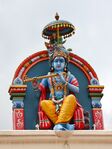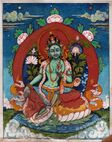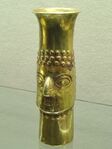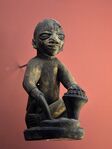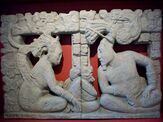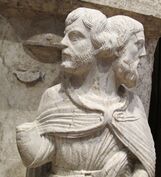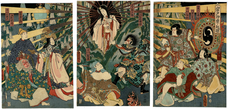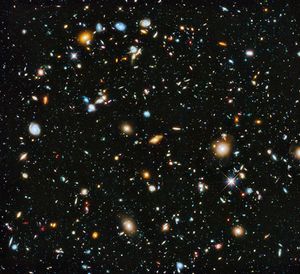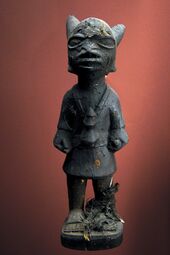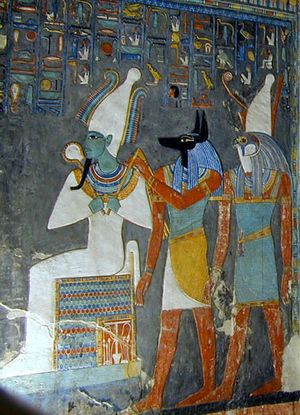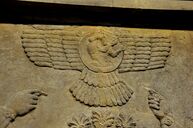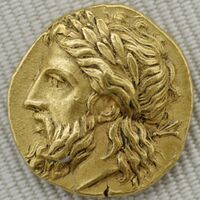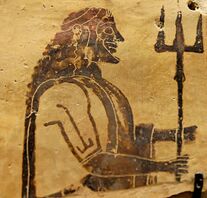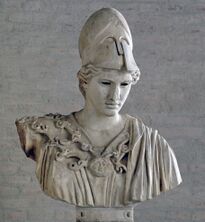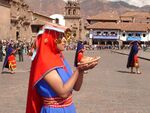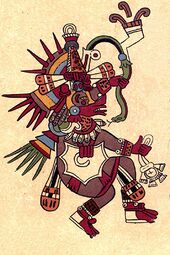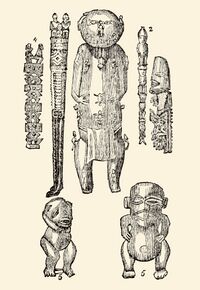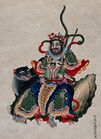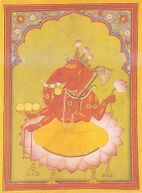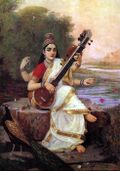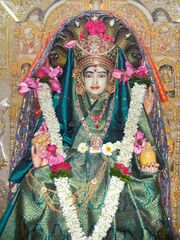إله
الإله (إنگليزية: deity، أو الرب (إنگليزية: god)، هو كيان خارق للطبيعة يعتبر من قبل معبوديه كياناً إلهياً أو مقدساً.[1] ويعترف ك. سكوت ليتلتون الإلهة على أنه "كيان يتمتع بقدرات أكبر من تلك الموجودة لدى البشر العاديين، لكنه يتفاعل مع البشر، إيجابًا أو سلبًا، بطرق تنقل البشر إلى [مستويات وعي جديدة، تتجاوز المشاغل الأساسية للحياة العادية".[2]
يمكن تصنيف الأديان من خلال عدد الآلهة التي يعبدونها. في الديانات التوحيدية يُعبد إلهاً واحداً فقط (يشار إليه غالبًا باسم "الله")،[3][4] بينما تقبل الديانات متعددة الآلهة بآلهة متعددة.[5] أما الديانات الهينوثية فتقبل بإله أسمى واحد دون إنكار الآلهة الأخرى، معتبرة إياهم جوانب لنفس المبدأ الإلهي.[6][7] بينما تنكر معتقدات اللاألوهية أي إله خالق خالد أسمى، لكنها تقبل پانثيون الآلهة التي تعيش وتموت وقد تولد من جديد مثل أي مخلوق آخر.[8][9]
على الرغم من أن معظم الديانات التوحيدية تتصور تقليديًا إلهها على أنه كلي القدرة، كلي الوجود، عالم بكل شيء ، مطلق الوجود، وأبدي،[10][11] لا شيء من هذه الصفات ضروري لتعريف "الإله"[12][13][14] وتصور مختلف الثقافات آلهتهم بشكل مختلف.[12][13] تشير الديانات التوحيدية عادةً إلى إلهها بعبارات ذكورية،[15][16] بينما تشير الديانات الأخرى إلى الآلهة بطرق متنوعة- ذكور، إناث، خناث، أو بلا جنس.[17][18][19]
تجسد العديد من الثقافات - بما في ذلك بلاد الرافدين القديمة والمصرية واليونانية والرومانية والجرمانية الظواهر الطبيعية، بأشكال مختلفة إما كأسباب أو آثار متعمدة.[20][21][22] اعتبرت بعض الآلهة الأبستاقية والڤيدية أنها مفاهيم أخلاقية.[20][21] في الديانات الهندية، تم تصور الآلهة على أنها تظهر داخل هيكل جسد كل كائن حي، كأعضاء حسية وعقل.[23][24][25] صورت الآلهة كشكل من أشكال الوجود (سامسارا) بعد الولادة الجديدة، للبشر الذين يكتسبون الجدارة من خلال الحياة الأخلاقية، حيث يصبحون الآلهة الأوصياء ويعيشون بسعادة في الجنة، لكنهم أيضًا عرضة للموت عند فقد استحقاقهم.[8][9]
التسمية
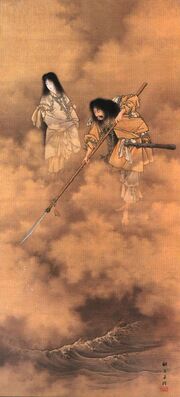
في اللغة الإنگليزية، كلمة إله مشتقة من الفرنسية القديمة deité،[26][صفحة مطلوبة] باللاتينية deitatem أو "طبيعة إلهية"، صاغها أوگستين من هيپو من deus ("إله").[27] ينتج هذا الجذر الكلمة الهندية القديمة ديڤا وتعني "الوميض أو البريق"، من *div- "الوميض"، وكذلك الكلمة اليونانية dios "إلهي" وزيوس؛ واللاتينية deus "إله" (اللاتينية القديمة deivos).[28][29][30] ديڤا هو الإله (المذكر)، والصيغة الأنثوية المرتبطة المكافئة له هي ديڤي.[31] اشتقاقياً، فالألفاظ القربية من ديڤي هي اللاتينية dea واليونانية thea.[32] بالفارسية القديمة، كلمة دايڤا- تعني "ديمون، الرب الشرير]]"، [29] بينما تعني العكس بالسنسكريتية، حيث تشير إلى "الأشياء السماوية، الإلهية، الأرضية ذات السامية والمتعالية والساطعة".[31][33][34]
وفقاً لدوگلاس هارپر، يشير "الله" المرتبط ارتباطاً وثيقاً إلى "الكائن الأسمى، الإله"،[35] وهو مشتق من الجرمانية الأولية *guthan، منPIE *ghut-، ويعني "من يتجه إليه بالدعاء".[30] أما كلمةGuth باللغة الأيرلندية فتعني "الصوت". مصطلح *ghut- هو أيضاً مصدر للكلمة السلاڤونية الكنسية القديمة zovo ("الذي يُدعى")، السنسكريتية huta- ("يُدعى"، an epithet of Indra)، من جذر *gheu(e)- ("الذي يُدعى، يتوسل إليه."),[35]
هناك أصل بديل لمصطلح "إله" يأتي من الجرمانية القديمة Gaut، والذي ينسبه إلى جذرPIE *ghu-to- ("poured")، المشتق من الجذر *gheu- ("to pour, pour a libation"). مصطلح *gheu- هو أيضاً جذر من اليونانية khein "to pour".[35] في الأصل كانت كلمة "الرب" god وغيرها من الكلمات الجرمانية المتشابهة عبارة عن أسماء محايدة لكنها تحولت إلى كونها ذكورية بشكل عام تحت تأثير المسيحية حيث يُنظر إلى الإله عادةً على أنه الذكر.[30][35] في المقابل، اعترفت جميع الثقافات والأساطير الهندو-أوروپية بكل من الآلهة المذكر والمؤنث.[34]
تعريفات
لا يوجد إجماع مقبول عالميًا على ماهية الإله،[1] وتختلف مفاهيم الآلهة اختلافًا كبيرًا بين الثقافات.[1] يقول هوو أوين أن مصطلح "إله أو رب أو ما يعادله في اللغات الأخرى" له مجموعة محيرة من المعاني والأهمية.[38] فهو يختلف من "كائن متسامي غير محدود خلق الكون وسيادته" (الله)، إلى "كيان أو تجربة محدودة، ذات أهمية خاصة أو تثير شعورًا خاصًا" (الرب)، إلى "مفهوم ديني أو فلسفي. السياق الذي يتعلق بالطبيعة أو الكائنات المكبرة أو عالم غير عادي"، إلى "العديد من الاستخدامات الأخرى".[38]
عادة يصور الإله كمفهوم خارق للطبيعة أو كمفهوم إلهي، يتجلى في الأفكار والمعرفة، في شكل يجمع بين التميز في بعض أو جميع الجوانب، ويتصارع مع الضعف والأسئلة في جوانب أخرى، بطل في النظرة والأفعال، لكنه مرتبط بالعواطف والرغبات.[39][40]
في حالات أخرى، يكون الإله مبدأ أو حقيقة مثل فكرة "الروح". على سبيل المثال، تصف الأبانيشاد الهندوسية أتمان (الروح، الذات) بـ "ديڤا" (الإله)، مما يؤكد أن "ديڤا" ومبدأ الأبدية الأسمى (براهمان) هو جزء من كل كائن حي، وأن هذه الروح روحية وإلهية، وأن إدراك معرفة الذات هو معرفة الأسمى.[41][42][43]
الإلوهية هو الإيمان بوجود إله واحد أو أكثر.[44][45] أما تعدد الآلهة فتؤمن بعبادة عدة آلهة،[46] التي عادة ما تجتمع في پانثيون الآلهة والإلهات، مع الطقوس المصاحبة.[46] في معظم الديانات المتعددة الآلهة، تمثل الآلهة والإلهات المختلفة تمثيلات لقوى الطبيعة أو مبادئ الأسلاف، ويمكن اعتبارها إما مستقلة أو منبثقة من الله الخالق أو المتعالي المبدأ المطلق (اللاهوت التوحيدي)، التي تتجلى جوهريًا في الطبيعة.[46] تقبل الهينوثية وجود أكثر من إله واحد، لكنها تعتبر جميع الآلهة تمثيلات أو جوانب معادلة لنفس المبدأ الإلهي، الأعلى.[7][47][6][48] أحادية العبادة هو الاعتقاد بوجود العديد من الآلهة، لكن يمكن للمرء أن يعبد واحد فقط من هذه الآلهة بشكل صحيح.[49][50]
أما التوحيدية فتعتقد أ هناك إله واحد موجود.[51][52][53][54][55][56][57][استشهاد مفرط] عادة ما يوصف الإله التوحيدي، المعروف باسم "الله"، على أنه كلي القدرة، كلي الوجود، عالم بكل شيء، وأبدي.[58] ومع ذلك، لم يُنظر إلى كل الآلهة بهذه الطريقة[12][14][59][60] ولا يحتاج الكيان إلى أن يكون قديرًا، أو كلي الوجود، أو عالم بكل شيء، أو أبديًا ليكون إلهاً.[12][14][59]
الربوبية هو الاعتقاد بوجود إله واحد فقط، هو الذي خلق الكون، لكنه لا يتدخل عادة في العالم الناتج.[61][62][63][صفحة مطلوبة] كانت الربوبية شائعة بشكل خاص بين المثقفين الغربيين خلال القرنين الثامن عشر والتاسع عشر.[64][65] أما الواحدية فتعتقد أن الكون نفسه إلهاً[36] أو أن كل شيء يؤلف إلهاً شاملاً جوهرياً.[37] الربوبية الكلية هي هو موقف وسيط بين المعتقدات السابقة، ويقترح أن الخالق أصبح الكون الواحدي.[66] تعتقد وحدة الوجود أن الوحدة هو الاعتقاد بأن الألوهية تسود الكون، لكنها أيضًا تتجاوز الكون.[67] اللاأدرية هو الموقف الذي يستحيل معه معرفة ما إذا كان هناك إله من أي نوع.[68][69][70] الإلحاد هو عدم الإعتقاد بوجود أي إله.[71]
ما قبل التاريخ
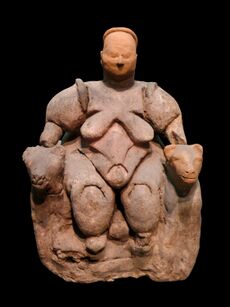
يستنتج العلماء احتمال وجود الآلهة في فترة ما قبل التاريخ من النقوش وفنون ما قبل التاريخ مثل رسومات الكهوف، لكن من غير الواضح ماهية هذه الرسومات واللوحات ولماذا تم صنعها.[74] تظهر بعض النقوش أو الرسومات التخطيطية حيوانات أو صيادين أو طقوسًا.[75] كان من الشائع أن يفسر علماء الآثار كل تمثال نسائي من عصور ما قبل التاريخ تقريبًا على أنه تمثيل لإلهة واحدة بدائية، وهي سلف آلهة مشهود لها تاريخيًا مثل إينانـّا، عشتار، عشروت، كوبليا وأفروديت؛[76] فقد هذا النهج مصداقيته بشكل عام الآن.[76] يدرك علماء الآثار المعاصرون عمومًا أنه من المستحيل تحديد أي تماثيل تعود إلى عصور ما قبل التاريخ بشكل قاطع على أنها تمثيلات لأي نوع من الآلهة، ناهيك عن الإلهات.[76] ومع ذلك، من الممكن تقييم التمثيلات القديمة على أساس كل حالة على حدة وتقييمها على مدى احتمالية تمثيلها لآلهة.[76] فسر البعض ڤينوس ڤيلندورف، وهو تمثال لأنثى عثر عليه في أوروپا ويرجع تاريخه إلى حوالي 25000 ق.م، على أنه نموذج للإله الأنثوي في عصور ما قبل التاريخ.[75] اكتشف عدد من التماثيل المحتملة للآلهة في عين غزال، شمال شرقي مدينة عمان[76] وتكشف الأعمال الفنية التي عُثر عليها في چاتلهويوك عن إشارات إلى ما قد يكون أسطورة معقدة.[76]
الأديان والثقافات
أفريقيا جنوب الصحراء
على مدار تاريخها، طورت الثقافات الأفريقية المتنوعة اللاهوت ومفاهيم الآلهة. في نيجيريا ودول غرب أفريقيا المجاورة، على سبيل المثال، هناك إلهان بارزان (يطلق عليهما محليًا أوريشا)[77] توجد في ديانة اليوروبا، أي الإله أوگون والإلهة أوسون.[77] أوگون هو الإله الذكوري البدائي بالإضافة إلى كوه الإله الوصي وحارس المهن مثل صنع الأدوات واستخدامها، وصناعة المعادن، والصيد، والحرب، والحماية، وتأكيد العدل والعدالة.[78][79] أما أوسون فهو إله أنثوي بدائي قوي بنفس القدر والإله الحارس متعدد الأبعاد للخصوبة والمياه والأمهات والصحة والعلاقات الاجتماعية والحب والسلام.[77] جُلب أوگون وأوسون إلى الأمريكتين على سفن الرقيق. حافظ عليهم الأفارقة في مجتمعاتهم الزراعية، ولا تزال مهرجاناتهم قائمة.[77][78]
في ثقافات جنوب أفريقيا، ظهر مزيج مشابه بين المذكر والمؤنث في أشكال أخرى، لا سيما مثل آلهة القمر والشمس.[80] يتكون علم الكونيات في جنوب أفريقيا من هايسبا أو كسوبا (الإله، الرب)، گاونى (الأرواح الشريرة) أو كوينى (الشعب). يتضمن هايسبا نلاديبا (الإله الذكر، خالق رب السماء) ونلاديسارا (الإلهات الإناث، زوجتي نلاديبا). يعتبر إله الشمس (مؤنث) والقمر (مذكر) أبناء لنلاديبا وزوجتيه نلاديسارا. يُنظر إلى الشمس والقمر على أنهما من مظاهر الإله الأعلى، وتوجه العبادة إليهما.[81] في الثقافات الأفريقية الأخرى، يُنظر إلى الشمس على أنها ذكر ، بينما يُنظر إلى القمر على أنه أنثى، وكلاهما رمزاً للألوهية.[82] في زيمبابوي، الإله الأعلى يكون خنثوي أنثوي المظهر يمتلك مظاهر الذكر والأنثى، يُنظر إليه على أنه مانح المطر، ويُعامل في نفس الوقت على أنه إله الظلام والنور ويسمى مواري شونا.[82] في منطقة بحيرة ڤكتوريا، يطلق على الإله مصطلح لوبآلى، أو جوك.[83]
الشرق الأدنى القديم
المصرية
كان قدماء المصريين يبجلون العديد من الآلهة. تسرد السجلات والنقوش المصرية أسماء العديد ممن تكون طبيعتهم غير معروفة وتقدم إشارات غامضة إلى آلهة أخرى غير معروفة.[85] يقدر عالم المصريات جيمس آلن أن هناك أكثر من 1.400 إله مدرجة أسماءهم في النصوص المصرية،[86] بينما يقدم كريستيان ليتز تقديرًا لـ "الآلاف والآلاف" من الآلهة المصرية.[87] كانوا يسمون الإلهة nṯr (الرب)، والإلهات nṯrt؛[88] ومع ذلك ، قد تنطبق هذه المصطلحات أيضًا على أي كائن - الأرواح والبشر المتوفين، لكن ليس الشياطين - الذين كانوا بطريقة ما خارج مجال الحياة اليومية.[89][88] عادة ما كان للآلهة المصرية عبادة ودور وأساطير مرتبطة.[89]
يوجد حوالي 200 إله بارز في نصوص الأهرام والمعابد القديمة في مصر، العديد منها حيواني الشكل. من بينها، مين (إله الخصوبة)، نيت (خالق الإلهات)، أنوبيس، أتون، بيس، حورس، إيزيس، رع، مرتسگر، نوت، أووزوريس، شو، سيا وتوت.[84] Most كانت الآلهة المصرية تمثل ظاهرة طبيعية أو أشياء مادية أو جوانب اجتماعية للحياة، كقوى جوهرية خفية داخل هذه الظواهر.[90][91] الإله شو، على سبيل المثال، يمثل الهواء؛ الإلهة مرتسگر تمثل أجزاء من الأرض، والإله سيا يمثل القوى المجردة للإدراك.[92] كانت آلهة مثل رع وأوزوريس يرتبطون بمحاكمة الأموات ورعايتهم في الحياة الآخرة.[84] غالبًا ما كان للآلهة الرئيسية أدوار متعددة وشاركوا في ظواهر متعددة.[92]
يعود أول دليل مكتوب للآلهة إلى أوائل الألفية الثالثة قبل الميلاد، ومن المحتمل أن يكون قد نشأ من معتقدات ما قبل التاريخ.[93] ومع ذلك، أصبحت الآلهة منظمة ومتطورة بعد تشكيل دولة مصرية تحت حكم الفراعنة ومعاملتهم على أنهم الملوك المقدسين الذين لديهم حقوق حصرية للتفاعل مع الآلهة، في الجزء الأخير من الألفية الثالثة قبل الميلاد.[94][85]
خلال القرون الأولى من الحقبة العامة، حيث تفاعل المصريون وتاجروا مع الثقافات المجاورة، تم تبني الآلهة الأجنبية وتكريمهم.[95][87]
الشامية
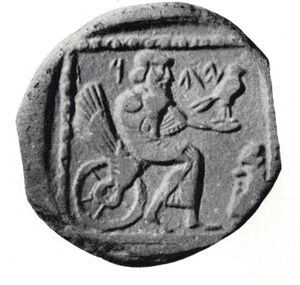
كان الكنعانيون القدماء مشركين يؤمنون بمجموعة من الآلهة،[96][97][98] كان كبير هؤلاء الآلهة هو الإله إل، الذي كان يحكم برفقة قرينته عشيرة وأبنائهم السبعون.[96][97][98] كان بعل هو إله العواصف والمطر والنباتات والخصوبة،[96] بينما كانت قرينته عناة إلهة الحرب[96] وعشتروت، الإلهة السامية الغربية المكافئة لعشتار، كانت إلهة الحب.[96] كان شعب مملكة إسرائيل ومملكة يهوذا يؤمنون في الأصل بهذه الآلهة،[96][98][99] بجانب إلههم القومي يهوه.[100][101] لاحقاً أصبح إيل [[توفيق بين الأديان|متوافقاً مع يهوه، ليتولى دور إيل كرئيس لمجمع الآلهة،[96] حيث كانت عشيرة قرينته الإلهية[102][96] وكان "أبناء إيل" ذريته.[96] في السنوات الأخيرة من مملكة يهوذا، صعد فصيل أحادي العبادة إلى السلطة وأصر على أن يهوه وحده هو الذي يصلح لعبادة شعب يهوذا.[96] تم فرضت العبادة الأحادية خلال إصلاحات الملك يوشياهو عام 621 ق.م.[96] أخيرًا، أثناء السبي البابلي، بدأ بعض أبناء يهوذا بتعليم أن الآلهة باستثناء الرب لم تكن فقط غير صالحة للعبادة، لكنها لم تكن موجودة.[103][38] كان "أبناء إيل" قد انخفضت مكانتهم من آلهة إلى ملائكة.[96]
بلاد الرافدين
في حضارة بلاد الرافدين القديمة بجنوب العراق كان هناك العديد من الدينجير (الآلهة والإلهات والأرباب).[16][104] كانت آلهة بلاد الرافدين مجسمة بشكل شبه حصري.[105][16][106] كان يعتقد أنها تمتلك قوى غير عادية[105] وغالبًا ما كان يُنظر إليها على أنها ذا حجم بدني هائل.[105] كانت خالدة بشكل عام،[105] لكن قلة منها، لا سيما دوموزيد، گشتإنانـّا ، وگوگالانا ماتوا أو زاروا العالم السفلي.[105] بُجلت الآلهة من الذكور والإناث على نطاق واسع.[105]
في الپانثيون السومري، كان للآلهة وظائف متعددة، بما في ذلك رعاية الإنجاب، والأمطار، والري، والزراعة، والقدر، والعدالة.[16] كانت الآلهة تُطعم وتكسى وتُسلى وتُعبد لمنع الكوارث الطبيعية وكذلك لمنع الفوضى الاجتماعية مثل النهب أو الاغتصاب أو الفظائع.[16][107][105] كان الكثير من الآلهة السومرية آلهة شفيعة للدول-المدن.[107]
عُرفت أهم الآلهة في الپانثيون السومري باسم أنـّوناكي،[108] والتي تتضمن الآلهة المعروفة باسم "الآلهة السبعة الذين يحكمون": أنو، إنليل، إنكي، ننحورساگ، نانا، أوتو، وإينانـّا.[108] بعد غزو سرگون الأكادي لسومر، تم التوفيق الكثير من الآلهة السومرية مع الآلهة السامية الشرقية.[107] الإلهة إينانـّا وُفقت مع عشار السامية الشرقية، وانتشرت عبادتها،[109][110][107][105] وأصبح لها معابد في أرجاء بلاد الرافدين.[111][105]
عالجت أساطير بلاد ما بين النهرين في الألفية الأولى قبل الميلاد أنشر (أشور لاحقاً) وكيشار كإلهين بدائيين.[112] كان مردوخ إلهاً هاماً بين البابليين. نشأ من إله غامض في الألفية الثالثة قبل الميلاد ليصبح أحد أهم آلهة بلاد الرافدين في الألفية الأولى قبل الميلاد. عبد البابليون مردوخ باعتباره خالق السماء والأرض والبشرية والإله القومي.[16][113] أيقونية مردوخ هي حيوانية الشكل وغالبًا ما توجد في البقايا الأثرية في الشرق الأوسط التي تم تصويرها على شكل "ثعبان-تنين" أو "هجين إنساني-حيواني".[114][115][116]
الإندو-أوروپية
الجرمانية
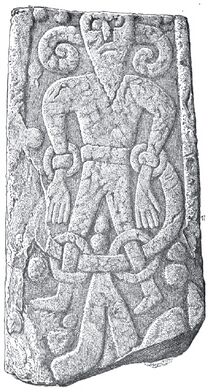
في اللغات الجرمانية، المصطلحات المصطلحة بكلمة "الرب" مثل الإنگليزية القديمة: god ونورسية القديمة: guð كانت في الأصل محايدة لكنها أصبحت ذكورية، كما هو الحال في اللغات الجرمانية الحديثة، بعد اعتناق المسيحية بسبب استخدامها في الإشارة إلى الرب المسيحي.[117]
في الأساطير النوردية، Æsir (المفرد áss أو ǫ́ss)، هي مجموعة الآلهة الرئيسية [118] بينما مصطلح ásynjur (المفرد ásynja) يشير بشكل خاص إلى Æsir الأنثى.[119] هذه المصطلحات، كما يقول جون ليندو، قد يرجع جذرها في النهاية إلى الكلمة الهندو-أوروپية التي تعني "التنفس" breath (كما في "الحياة تعطي القوة")، وهي قريبة من الإنگليزية القديمة: os (الرب الهايثي) والقوطية: anses.[120]
هناك مجموعة أخرى من الآلهة في الأساطير النوردية تسمى ڤانير، وهي مرتبطة بالخصوبة. دخل Æsir وڤانير في حرب، بحسب المراجع النوردية. تصف الرواية في ملحمة ينگلينگا أن حرب Æsir–ڤانير قد انتهى بهدنة والمصالحة النهائية بين الاثنين في مجموعة واحدة من الآلهة، بعد أن اختار الطرفان السلام وتبادل السفراء (الرهائن)،[121] والزواج فيما بين الطرفين.[120][122]
تصف الأساطير الإسكندناڤية التعاون ما بعد الحرب، بالإضافة إلى الاختلافات بين "Æsir" و"ڤانير" التي اعتبرها الطرف الآخر فاضحة.[121] قامت الإلهة فرييا من ڤانير بتعليم السحر لـÆsir، بينما اكتشف الجانبان أن Æsir حرم التزاوج بين الأشقاء، وسمح ڤانير بهذا النوع من التزاوج.[121][123][124]
تضم المعابد صور للآلهة الجرمانية (مثل ثور، اودن وفرييا)، بالإضافة إلى طقوس العبادة الوثنية، التي استمرت في اسكندناڤيا حتى القرن الثاني عشر، وفقًا للسجلات التاريخية. اقترح أنه بمرور الوقت، استبدلت الآلهة الجرمانية بالاعتقادات المسيحية للمساعدة في قمع الوثنية كجزء من تنصير الشعوب الجرمانية.[121]
تم إحياء عبادة الآلهة الجرمانية في العصر الحديث كجزء من حركة دينية جديدة تسمى هيثنري.[125]
اليونانية
كان اليونانيون القدماء يبجلون الآلهة والإلهات.[126] واستمر تبجيلها خلال القرون الأولى من العصر المشترك، العديد من الآلهة اليونانية، استلهمت وتم تبنيها كجزء من مجموعة أكبر بكثير من الآلهة الرومانية.[127] كانت الديانة اليونانية متعددة الآلهة، لكن لم يكن لها معبد مركزي ولا نصوص مقدسة.[127] ارتبطت الآلهة إلى حد كبير بالأساطير وكانت تمثل ظواهر طبيعية أو جوانب من السلوك البشري.[126][127]
قد ترجع العديد من الآلهة اليونانية إلى التقاليد الهندية الأوروپية القديمة، حيث إن الآلهة والإلهات الموجودة في الثقافات البعيدة يمكن مقارنتها من الناحية الأسطورية وهي متقاربة.[30][128] Eos, إلهة الفجر اليونانية ، على سبيل المثال، شبيهة بالإلهة أوشاس الهندية، أورورا الرومانية، وأوسكليس اللاتڤيتة.[30] ملك الآلهة اليوناني .يوس، مقارب للإله اللاتيني إوپيتر، والجرماني القديم زيو، والهندي دايوس، الذين يتشاركون معهم أساطير مماثلة.[30][129] آلهة اخرى، مثل أفروديت، يرجع أصلها إلى الشرق الأدنى القديم.[130][131][132][133]
كانت الآلهة اليونانية تختلف محلياً، لكن المهرجانات والطقوس وقواعد الطقوس المماثلة كانت ذات موضوعات هيلينية مشتركة.[134] كان الأولمپيون الاثنى عشر هم أهم الآلهة في الپانثيون اليوناني: زيوس، هيرا، پوسايدون، أثينا، أپولو، آرتميس، أفروديت، هرميس، دميتر، ديونيسوس، هفستوس وآرس.[128] تتضمن الآلهة اليونانية الهامة الأخرى هستيا، هادس، وهراقليس.[127] هذه الآلهة الأخيرة مستوحاة من مجرة الآلهة الرومانية Dii Consentes.[127]
بجانب الأولمپيون، كان اليونانيون يعبدون أيضاً عدد من الآلهة المحلية.[128][135] من بين هؤلاء الآله پان بقدمي الماعز (الوصي على الرعاة وقطعانهم)، الحوريات (أرواح الطبيعة المرتبطة بأشكال معينة من الأرض)، الناياد (الذين يسكنون الينابيع)، الدرياد (أرواح الأشجار)، النيريد (الذين يسكنون البحر)، آلهة الأنهار، الساتير (نوع من أرواح الطبيعة الذكورية الشهوانية)، وغيرها. تم تمثيل القوى المظلمة للعالم السفلي من قبل إرينيز (أو فوريز)، قيل إنها تلاحق المذنبين بارتكاب جرائم ضد أقارب الدم.[135]
كانت الآلهة اليونانية مجسمة، مثل تلك الموجودة في العديد من التقاليد الهندية الأوروپية الأخرى. يصفهم والتر بركيرت بأنهم "أشخاص وليسوا أفكار مجردة أو أفكار أو مفاهيم".[128] كانت لديهم قدرات وقوى رائعة. يتمتع كل منهم ببعض الخبرة الفريدة، وفي بعض الجوانب، يتمتع بشخصية خاصة ومعيبة.[136] لم يكونوا كليو القدرة ويمكن أن يصابوا في بعض الظروف.[137] أدت الآلهة اليونانية إلى العبادات، واستُخدمت سياسيًا وأقيمت لها اقرابين النذرية من أجل بركتها مثل المحاصيل الوفيرة، أو الأسرة السليمة، أو النصر في الحرب، أو السلام للأحباء المتوفين مؤخرًا.[127][138]
الرومانية
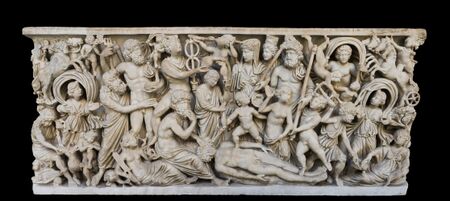
كان الپانثيون الروماني يضم العديد من الآلهة، اليونانية وغير اليونانية.[127] كانت الآلهة الأكثر شهرة، الموجودة في الأساطير والفنون الأوروپية في الألفية الثانية، هي الآلهة المجسمة التي دُمجت مع الآلهة اليونانية. وتشمل هذه الآلهة الستة والإلهات الست: ڤينوس، أپولو، مارس، ديانا، مينرڤا، سيرس، ڤولكان، جونو، مركوري، ڤستا، نپتون، جوپيتر (جوڤ، زيوس)؛ وكذلك باخوس وپلوتو وهرقليوس.[127][139] كانت الآلهة الغير يونانية الرئيسية تتضمن جانوس، فورتونا، ڤستا، كويرينوس وتلوس (الإلهة الأم، يعتقد أنها الأقدم).[127][140] من المحتمل أن أصول بعض الآلهة غير اليونانية تعود إلى الثقافة الأوروبپة القديمة مثل الديانة الجرمانية القديمة، بينما ربما قد أستغير البعض الآخر، لأسباب سياسية، من المراكز التجارية المجاورة مثل تلك الموجودة في المينوية أو الحضارة المصرية القديمة.[141][142][143]
ألهمت الآلهة الرومانية، على غرار الإغريق القدماء، المهرجانات والطقوس والتضحيات المجتمعية التي يقودها الفلامين (الكهنة، الپبونتيفيون)، لكن الكاهنات (العذارى) كانوا أيضًا يحظون بتقدير كبير للحفاظ على النار المقدسة المستخدمة في الطقوس النذرية للآلهة.[127] كما كانت الآلهة تحفظ في أضرحة خاصة (lararium)، مثل هستيا المكرمة في المنازل باعتبارها إلهة موقد النار.[127][144] كانت هذه الديانة الرومانية تقديسًا للنار المقدسة، وهذا موجود أيضًا في الثقافة العبرية (اللاويين 6)، وحوما في الثقافة الڤيدية، والإغريق القدماء والثقافات الأخرى.[144]
كتب العلماء الرومان القدماء مثل ڤارو وشيشرون أطروحات عن طبيعة الآلهة في عصرهم.[145] يقول ڤارو في Antiquitates Rerum Divinarum، أن الرجل المؤمن بالخرافات هو الذي يخاف الآلهة، بينما الشخص المتدين حقًا يبجلهم كأبوين.[145] ويقول شيشرون في مؤلفه أكاديمكا، أشاد ڤارو بهذا وغيرها من الرؤى.[145] بحسب ڤارو، هناك ثلاث روايات عن الآلهة في المجتمع الروماني: الرواية الأسطورية التي أسسها الشعراء للمسرح والترفيه، والرواية المدنية التي يستخدمها الناس للتبجيل وكذلك المدينة، والرواية الطبيعية التي أسسها الفلاسفة.[146] ويضيف ڤاروأن أفضل حالة هي حيث يجمع اللاهوت المدني بين الرواية الأسطورية الشعرية ورواية الفيلسوف.[146] استمر تبجيل الآلهة الرومانية في أوروپا خلال عصر قسطنطين، وما بعد عام 313 م عندما أصدر مرسوم التسامح.[136]
الأمريكية الأصلية
الإنكا
The Inca culture has believed in Viracocha (also called Pachacutec) as the creator deity.[147][148] Viracocha has been an abstract deity to Inca culture, one who existed before he created space and time.[149] All other deities of the Inca people have corresponded to elements of nature.[147][148] Of these, the most important ones have been Inti (sun deity) responsible for agricultural prosperity and as the father of the first Inca king, and Mama Qucha the goddess of the sea, lakes, rivers and waters.[147] Inti in some mythologies is the son of Viracocha and Mama Qucha.[147][150]
Oh creator and Sun and Thunder,
be forever copious,
do not make us old,
let all things be at peace,
multiply the people,
and let there be food,
and let all things be fruitful.
—Inti Raymi prayers[151]
Inca people have revered many male and female deities. Among the feminine deities have been Mama Kuka (goddess of joy), Mama Ch'aska (goddess of dawn), Mama Allpa (goddess of harvest and earth, sometimes called Mama Pacha or Pachamama), Mama Killa (moon goddess) and Mama Sara (goddess of grain).[150][147] During and after the imposition of Christianity during Spanish colonialism, the Inca people retained their original beliefs in deities through syncretism, where they overlay the Christian God and teachings over their original beliefs and practices.[152][153][154] The male deity Inti became accepted as the Christian God, but the Andean rituals centered around Inca deities have been retained and continued thereafter into the modern era by the Inca people.[154][155]
المايا والأزتك
In Maya culture, Kukulkan has been the supreme creator deity, also revered as the god of reincarnation, water, fertility and wind.[148] The Maya people built step pyramid temples to honor Kukulkan, aligning them to the Sun's position on the spring equinox.[148] Other deities found at Maya archaeological sites include Xib Chac – the benevolent male rain deity, and Ixchel – the benevolent female earth, weaving and pregnancy goddess.[148] The Maya calendar had 18 months, each with 20 days (and five unlucky days of Uayeb); each month had a presiding deity, who inspired social rituals, special trading markets and community festivals.[155]
A deity with aspects similar to Kulkulkan in the Aztec culture has been called Quetzalcoatl.[148] However, states Timothy Insoll, the Aztec ideas of deity remain poorly understood. What has been assumed is based on what was constructed by Christian missionaries. The deity concept was likely more complex than these historical records.[156] In Aztec culture, there were hundred of deities, but many were henotheistic incarnations of one another (similar to the avatar concept of Hinduism). Unlike Hinduism and other cultures, Aztec deities were usually not anthropomorphic, and were instead zoomorphic or hybrid icons associated with spirits, natural phenomena or forces.[156][157] The Aztec deities were often represented through ceramic figurines, revered in home shrines.[156][158]
الپولينيزية
The Polynesian people developed a theology centered on numerous deities, with clusters of islands having different names for the same idea. There are great deities found across the Pacific Ocean. Some deities are found widely, and there are many local deities whose worship is limited to one or a few islands or sometimes to isolated villages on the same island.[159]
The Māori people, of what is now New Zealand, called the supreme being as Io, who is also referred elsewhere as Iho-Iho, Io-Mataaho, Io Nui, Te Io Ora, Io Matua Te Kora among other names.[160] The Io deity has been revered as the original uncreated creator, with power of life, with nothing outside or beyond him.[160]Other deities in the Polynesian pantheon include Tangaloa (god who created men),[159] La'a Maomao (god of winds), Tu-Matauenga or Ku (god of war), Tu-Metua (mother goddess), Kane (god of procreation) and Rangi (sky god father).[160]
The Polynesian deities have been part of a sophisticated theology, addressing questions of creation, the nature of existence, guardians in daily lives as well as during wars, natural phenomena, good and evil spirits, priestly rituals, as well as linked to the journey of the souls of the dead.[159]
الإبراهيمية
المسيحية
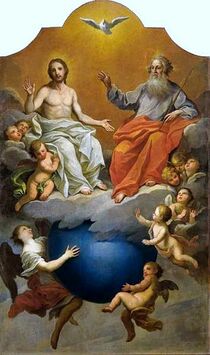
Christianity is a monotheistic religion in which most mainstream congregations and denominations accept the concept of the Holy Trinity.[161] Modern orthodox Christians believe that the Trinity is composed of three equal, cosubstantial persons: God the Father, God the Son, and the Holy Spirit.[161] The first person to describe the persons of the Trinity as homooúsios (ὁμοούσιος; "of the same substance") was the Church Father Origen.[162] Although most early Christian theologians (including Origen) were Subordinationists,[163] who believed that the Father was superior to the Son and the Son superior to the Holy Spirit,[162][164][165] this belief was condemned as heretical by the First Council of Nicaea in the fourth century, which declared that all three persons of the Trinity are equal.[163] Christians regard the universe as an element in God's actualization[161] and the Holy Spirit is seen as the divine essence that is "the unity and relation of the Father and the Son".[161] According to George Hunsinger, the doctrine of the Trinity justifies worship in a Church, wherein Jesus Christ is deemed to be a full deity with the Christian cross as his icon.[161]
The theological examination of Jesus Christ, of divine grace in incarnation, his non-transferability and completeness has been a historic topic. For example, the Council of Chalcedon in 451 CE declared that in "one person Jesus Christ, fullness of deity and fullness of humanity are united, the union of the natures being such that they can neither be divided nor confused".[166] Jesus Christ, according to the New Testament, is the self-disclosure of the one, true God, both in his teaching and in his person; Christ, in Christian faith, is considered the incarnation of God.[38][167][168]
الإسلام
Ilah, ʾIlāh (العربية: إله; plural: آلهة ʾālihah), is an Arabic word meaning "god".[169][170] It appears in the name of the monotheistic god of Islam as Allah (al-Lāh).[171][172][173] which literally means "the god" in Arabic.[169][170] Islam is strictly monotheistic[174] and the first statement of the shahada, or Muslim confession of faith, is that "there is no ʾilāh (deity) but al-Lāh (God)",[175] who is perfectly unified and utterly indivisible.[174][175][176]
The term Allah is used by Muslims for God. The Persian word Khuda (Persian: خدا) can be translated as god, lord or king, and is also used today to refer to God in Islam by Persian, Urdu, Tat and Kurdish speakers. The Turkic word for god is Tengri; it exists as Tanrı in Turkish.
اليهودية

Judaism affirms the existence of one God (Yahweh, or YHWH), who is not abstract, but He who revealed himself throughout Jewish history particularly during the Exodus and the Exile.[38] Judaism reflects a monotheism that gradually arose, was affirmed with certainty in the sixth century "Second Isaiah", and has ever since been the axiomatic basis of its theology.[38]
The classical presentation of Judaism has been as a monotheistic faith that rejected deities and related idolatry.[177] However, states Breslauer, modern scholarship suggests that idolatry was not absent in biblical faith, and it resurfaced multiple times in Jewish religious life.[177] The rabbinic texts and other secondary Jewish literature suggest worship of material objects and natural phenomena through the medieval era, while the core teachings of Judaism maintained monotheism.[177][178][صفحة مطلوبة]
According to Aryeh Kaplan, God is always referred to as "He" in Judaism, "not to imply that the concept of sex or gender applies to God", but because "there is no neuter in the Hebrew language, and the Hebrew word for God is a masculine noun" as he "is an active rather than a passive creative force".[179]
المندائية
In Mandaeism, Hayyi Rabbi (lit=The Great Life), or 'The Great Living God',[180] is the supreme God from which all things emanate. He is also known as 'The First Life', since during the creation of the material world, Yushamin emanated from Hayyi Rabbi as the "Second Life."[181] "The principles of the Mandaean doctrine: the belief of the only one great God, Hayyi Rabbi, to whom all absolute properties belong; He created all the worlds, formed the soul through his power, and placed it by means of angels into the human body. So He created Adam and Eve, the first man and woman."[182] Mandaeans recognize God to be the eternal, creator of all, the one and only in domination who has no partner.[183]
الآسيوية
الأنيتسية
Anitism, composed of a diverse array of indigenous religions from the Philippines, has multiple pantheon of deities, with each ethnic group having their own. The most notable deities are almost always the deity or deities considered by specific ethnic groups as their supreme deity or deities.[184]
Bathala is the Tagalog supreme deity,[185] while Mangechay is the Kapampangan supreme deity.[186] The Sambal supreme deity is Malayari,[187] the Blaan supreme deity is Melu,[188] the Bisaya supreme deity is Kaptan,[189] and so on. There are more than a hundred different ethnic groups in the Philippines, each having their own supreme deity or deities. Each supreme deity or deities normally rules over a pantheon of deities, contributing to the sheer diversity of deities in Anitism.[184]
البوذية
Buddhists do not believe in a creator deity.[190] However, deities are an essential part of Buddhist teachings about cosmology, rebirth, and saṃsāra.[190] Buddhist deities (such as devas and bodhisattvas) are believed to reside in a pleasant, heavenly realm within Buddhist cosmology, which is typically subdivided into twenty six sub-realms.[191][190][8]
Devas are numerous, but they are still mortal;[191] they live in the heavenly realm, then die and are reborn like all other beings.[191] A rebirth in the heavenly realm is believed to be the result of leading an ethical life and accumulating very good karma.[191] A deva does not need to work, and is able to enjoy in the heavenly realm all pleasures found on Earth. However, the pleasures of this realm lead to attachment (upādāna), lack of spiritual pursuits, and therefore no nirvana.[8] The vast majority of Buddhist lay people in countries practicing Theravada, states Kevin Trainor, have historically pursued Buddhist rituals and practices because they are motivated by their potential rebirth into the deva realm.[191][192][193] The deva realm in Buddhist practice in Southeast Asia and East Asia, states Keown, include gods found in Hindu traditions such as Indra and Brahma, and concepts in Hindu cosmology such as Mount Meru.[8]
Mahayana Buddhism also includes different kinds of deities, such as numerous Buddhas, bodhisattvas and fierce deities.
الهندوسية
The concept of God varies in Hinduism, it being a diverse system of thought with beliefs spanning henotheism, monotheism, polytheism, panentheism, pantheism and monism among others.[194][195]
In the ancient Vedic texts of Hinduism, a deity is often referred to as Deva (god) or Devi (goddess).[31][33] The root of these terms mean "heavenly, divine, anything of excellence".[31][33] Deva is masculine, and the related feminine equivalent is devi. In the earliest Vedic literature, all supernatural beings are called Asuras.[196][31] Over time, those with a benevolent nature become deities and are referred to as Sura, Deva or Devi.[196][197]
Devas or deities in Hindu texts differ from Greek or Roman theodicy, states Ray Billington, because many Hindu traditions believe that a human being has the potential to be reborn as a deva (or devi), by living an ethical life and building up saintly karma.[198] Such a deva enjoys heavenly bliss, till the merit runs out, and then the soul (gender neutral) is reborn again into Saṃsāra. Thus deities are henotheistic manifestations, embodiments and consequence of the virtuous, the noble, the saint-like living in many Hindu traditions.[198]
الجاينية
Like many ancient Indian traditions, Jainism does not believe in a creator, omnipotent, omniscient, eternal God; however, the cosmology of Jainism incorporates a meaningful causality-driven reality, and includes four realms of existence (gati), and one of them for deva (celestial beings, gods).[9] A human being can choose and live an ethical life (karma), such as being non-violent (ahimsa) against all living beings, thereby gain merit and be reborn as deva.[9][199]
Jain texts reject a trans-cosmic God, one who stands outside of the universe and lords over it, but they state that the world is full of devas who are in human-image with sensory organs, with the power of reason, conscious, compassionate and with finite life.[9] Jainism believes in the existence of the soul (Self, atman) and considers it to have "god-quality", whose knowledge and liberation is the ultimate spiritual goal in both religions. Jains also believe that the spiritual nobleness of perfected souls (Jina) and devas make them worship-worthy beings, with powers of guardianship and guidance to better karma. In Jain temples or festivals, the Jinas and Devas are revered.[9][200]
الزرداشتية
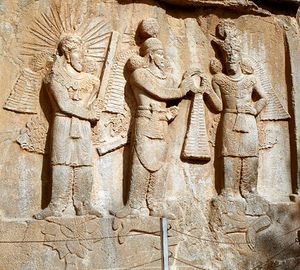
Ahura Mazda (/əˌhʊrəˌmæzdə/);[201] is the Avestan name for the creator and sole God of Zoroastrianism.[202] The literal meaning of the word Ahura is "mighty" or "lord" and Mazda is wisdom.[202] Zoroaster, the founder of Zoroastrianism, taught that Ahura Mazda is the most powerful being in all of the existence[203] and the only deity who is worthy of the highest veneration.[203] Nonetheless, Ahura Mazda is not omnipotent because his evil twin brother Angra Mainyu is nearly as powerful as him.[203] Zoroaster taught that the daevas were evil spirits created by Angra Mainyu to sow evil in the world[203] and that all people must choose between the goodness of Ahura Mazda and the evil of Angra Mainyu.[203] According to Zoroaster, Ahura Mazda will eventually defeat Angra Mainyu and good will triumph over evil once and for all.[203] Ahura Mazda was the most important deity in the ancient Achaemenid Empire.[204] He was originally represented anthropomorphically,[202] but, by the end of the Sasanian Empire, Zoroastrianism had become fully aniconic.[202]
تفسيرات متشككة
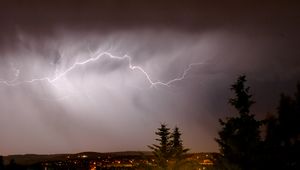
Attempts to rationally explain belief in deities extend all the way back to ancient Greece.[128] The Greek philosopher Democritus argued that the concept of deities arose when human beings observed natural phenomena such as lightning, solar eclipses, and the changing of the seasons.[128] Later, in the third century BCE, the scholar Euhemerus argued in his book Sacred History that the gods were originally flesh-and-blood mortal kings who were posthumously deified, and that religion was therefore the continuation of these kings' mortal reigns, a view now known as Euhemerism.[205] Sigmund Freud suggested that God concepts are a projection of one's father.[206]
A tendency to believe in deities and other supernatural beings may be an integral part of the human consciousness.[207][208][209][210] Children are naturally inclined to believe in supernatural entities such as gods, spirits, and demons, even without being introduced into a particular religious tradition.[210] Humans have an overactive agency detection system,[207][211][210] which has a tendency to conclude that events are caused by intelligent entities, even if they really are not.[207][211] This is a system which may have evolved to cope with threats to the survival of human ancestors:[207] in the wild, a person who perceived intelligent and potentially dangerous beings everywhere was more likely to survive than a person who failed to perceive actual threats, such as wild animals or human enemies.[207][210] Humans are also inclined to think teleologically and ascribe meaning and significance to their surroundings, a trait which may lead people to believe in a creator-deity.[212] This may have developed as a side effect of human social intelligence, the ability to discern what other people are thinking.[212]
Stories of encounters with supernatural beings are especially likely to be retold, passed on, and embellished due to their descriptions of standard ontological categories (person, artifact, animal, plant, natural object) with counterintuitive properties (humans that are invisible, houses that remember what happened in them, etc.).[213] As belief in deities spread, humans may have attributed anthropomorphic thought processes to them,[214] leading to the idea of leaving offerings to the gods and praying to them for assistance,[214] ideas which are seen in all cultures around the world.[207]
Sociologists of religion have proposed that the personality and characteristics of deities may reflect a culture's sense of self-esteem and that a culture projects its revered values into deities and in spiritual terms. The cherished, desired or sought human personality is congruent with the personality it defines to be gods.[206] Lonely and fearful societies tend to invent wrathful, violent, submission-seeking deities, while happier and secure societies tend to invent loving, non-violent, compassionate deities.[206] Émile Durkheim states that gods represent an extension of human social life to include supernatural beings. According to Matt Rossano, God concepts may be a means of enforcing morality and building more cooperative community groups.[215]
انظر أيضاً
المصادر
- ^ أ ب ت O'Brien, Jodi (2009). Encyclopedia of Gender and Society (in الإنجليزية). Los Angeles: Sage. p. 191. ISBN 978-1-4129-0916-7. Retrieved 28 June 2017.
- ^ Littleton, C. Scott (2005). Gods, Goddesses, and Mythology (in الإنجليزية). New York: Marshall Cavendish. p. 378. ISBN 978-0-7614-7559-0. Retrieved 28 June 2017.
- ^ Becking, Bob; Dijkstra, Meindert; Korpel, Marjo; Vriezen, Karel (2001). Only One God?: Monotheism in Ancient Israel and the Veneration of the Goddess Asherah (in الإنجليزية). London: New York. p. 189. ISBN 978-0-567-23212-0. Retrieved 28 June 2017.
The Christian tradition is, in imitation of Judaism, a monotheistic religion. This implies that believers accept the existence of only one God. Other deities either do not exist, are considered inferior, are seen as the product of human imagination, or are dismissed as remnants of a persistent paganism
- ^ Korte, Anne-Marie; Haardt, Maaike De (2009). The Boundaries of Monotheism: Interdisciplinary Explorations Into the Foundations of Western Monotheism (in الإنجليزية). Brill. p. 9. ISBN 978-90-04-17316-3. Retrieved 28 June 2017.
- ^ Brown, Jeannine K. (2007). Scripture as Communication: Introducing Biblical Hermeneutics (in الإنجليزية). Baker Academic. p. 72. ISBN 978-0-8010-2788-8. Retrieved 28 June 2017.
- ^ أ ب Taliaferro, Charles; Harrison, Victoria S.; Goetz, Stewart (2012). The Routledge Companion to Theism (in الإنجليزية). Routledge. pp. 78–79. ISBN 978-1-136-33823-6. Retrieved 28 June 2017.
- ^ أ ب Reat, N. Ross; Perry, Edmund F. (1991). A World Theology: The Central Spiritual Reality of Humankind (in الإنجليزية). Cambridge University Press. pp. 73–75. ISBN 978-0-521-33159-3. Retrieved 28 June 2017.
- ^ أ ب ت ث ج Keown, Damien (2013). Buddhism: A Very Short Introduction (in الإنجليزية) (New ed.). Oxford: Oxford University Press. ISBN 978-0-19-966383-5. Retrieved 22 June 2017.
- ^ أ ب ت ث ج ح Bullivant, Stephen; Ruse, Michael (2013). The Oxford Handbook of Atheism (in الإنجليزية). Oxford University Publishing. ISBN 978-0-19-964465-0. Retrieved 22 June 2017.
- ^ Taliaferro, Charles; Marty, Elsa J. (2010). A Dictionary of Philosophy of Religion. A&C Black. pp. 98–99. ISBN 978-1-4411-1197-5.
- ^ Trigger, Bruce G. (2003). Understanding Early Civilizations: A Comparative Study (1st ed.). Cambridge University Press. pp. 473–74. ISBN 978-0-521-82245-9.
- ^ أ ب ت ث Hood, Robert Earl (1990). Must God Remain Greek?: Afro Cultures and God-talk. Fortress Press. pp. 128–29. ISBN 978-1-4514-1726-5.
African people may describe their deities as strong, but not omnipotent; wise but not omniscient; old but not eternal; great but not omnipresent (...)
- ^ أ ب Trigger, Bruce G. (2003). Understanding Early Civilizations: A Comparative Study (1st ed.). Cambridge: Cambridge University Press. pp. 441–42. ISBN 978-0-521-82245-9.
[Historically...] people perceived far fewer differences between themselves and the gods than the adherents of modern monotheistic religions. Deities were not thought to be omniscient or omnipotent and were rarely believed to be changeless or eternal
- ^ أ ب ت Murdoch, John (1861). English Translations of Select Tracts, Published in India: With an Introd. Containing Lists of the Tracts in Each Language. Graves. pp. 141–42.
We [monotheists] find by reason and revelation that God is omniscient, omnipotent, most holy, etc., but the Hindu deities possess none of those attributes. It is mentioned in their Shastras that their deities were all vanquished by the Asurs, while they fought in the heavens, and for fear of whom they left their abodes. This plainly shows that they are not omnipotent.
- ^ Kramarae, Cheris; Spender, Dale (2004). Routledge International Encyclopedia of Women: Global Women's Issues and Knowledge (in الإنجليزية). Routledge. p. 655. ISBN 978-1-135-96315-6. Retrieved 28 June 2017.
- ^ أ ب ت ث ج ح O'Brien, Julia M. (2014). Oxford Encyclopedia of the Bible and Gender Studies (in الإنجليزية). Oxford University Press, Incorporated. ISBN 978-0-19-983699-4. Retrieved 22 June 2017.
- ^ Bonnefoy, Yves (1992). Roman and European Mythologies (in الإنجليزية). Chicago: University of Chicago Press. pp. 274–75. ISBN 978-0-226-06455-0. Retrieved 28 June 2017.
- ^ Pintchman, Tracy (2014). Seeking Mahadevi: Constructing the Identities of the Hindu Great Goddess (in الإنجليزية). SUNY Press. pp. 1–2, 19–20. ISBN 978-0-7914-9049-5. Retrieved 28 June 2017.
- ^ Roberts, Nathaniel (2016). To Be Cared For: The Power of Conversion and Foreignness of Belonging in an Indian Slum (in الإنجليزية). University of California Press. p. xv. ISBN 978-0-520-96363-4. Retrieved 28 June 2017.
- ^ أ ب Malandra, William W. (1983). An Introduction to Ancient Iranian Religion: Readings from the Avesta and the Achaemenid Inscriptions (in الإنجليزية). Minneapolis, MN: University of Minnesota Press. pp. 9–10. ISBN 978-0-8166-1115-7. Retrieved 28 June 2017.
- ^ أ ب Fløistad, Guttorm (2010). Volume 10: Philosophy of Religion (in الإنجليزية) (1st ed.). Dordrecht: Springer Science & Business Media B.V. pp. 19–20. ISBN 978-90-481-3527-1. Retrieved 28 June 2017.
- ^ Potts, Daniel T. (1997). Mesopotamian Civilization: The Material Foundations (st ed.). Ithaca, NY: Cornell University Press. pp. 272–74. ISBN 978-0-8014-3339-9. Retrieved 22 January 2018.
- ^ Potter, Karl H. (2014). The Encyclopedia of Indian Philosophies, Volume 3: Advaita Vedanta up to Samkara and His Pupils (in الإنجليزية). Princeton University Press. pp. 272–74. ISBN 978-1-4008-5651-0. Retrieved 28 June 2017.
- ^ Olivelle, Patrick (2006). The Samnyasa Upanisads: Hindu Scriptures on Asceticism and Renunciation (in الإنجليزية). New York: Oxford University Press. p. 47. ISBN 978-0-19-536137-7. Retrieved 28 June 2017.
- ^ Cush, Denise; Robinson, Catherine; York, Michael (2008). Encyclopedia of Hinduism (in الإنجليزية). London: Routledge. pp. 899–900. ISBN 978-1-135-18979-2. Retrieved 28 June 2017.
- ^ Hoad, T. F. (2008). The Concise Oxford Dictionary of English Etymology (in الإنجليزية). Paw Prints. ISBN 978-1-4395-0571-7. Retrieved 28 June 2017.
- ^ "Online Etymology Dictionary – Deity". Etymonline.com. Archived from the original on 18 August 2017. Retrieved 6 June 2017.
- ^ "Online Etymology Dictionary – Deva". Etymonline.com. Archived from the original on 18 August 2017. Retrieved 6 June 2017.
- ^ أ ب "Online Etymology Dictionary – Zeus". Etymonline.com. Archived from the original on 18 August 2017. Retrieved 6 June 2017.
- ^ أ ب ت ث ج ح Mallory, J.P.; Adams, D.Q. (1997). Encyclopedia of Indo-European Culture (in الإنجليزية) (1st ed.). London: Fitzroy Dearborn. ISBN 978-1-884964-98-5. Retrieved 22 June 2017.
- ^ أ ب ت ث ج Monier-Williams, Monier; Leumann, Ernst; Cappeller, Carl (2005). A Sanskrit-English Dictionary: Etymologically and Philologically Arranged with Special Reference to Cognate Indo-European Languages (in الإنجليزية) (Corrected ed.). Delhi: Motilal Banarsidass. ISBN 978-81-208-3105-6. Retrieved 28 June 2017.
- ^ Hawley, John Stratton; Wulff, Donna M. (1998). Devī: Goddesses of India (1st ed.). Motilal Banarsidass. pp. 2, 18–21. ISBN 978-81-208-1491-2.
- ^ أ ب ت Klostermaier, Klaus K. (2010). Survey of Hinduism, A: Third Edition (3rd ed.). SUNY Press. pp. 101–02. ISBN 978-0-7914-8011-3.
- ^ أ ب Mallory, J.P.; Adams, D.Q. (2006). The Oxford Introduction to Proto-Indo-European and the Proto-Indo-European world (in الإنجليزية) (Reprint ed.). Oxford: Oxford University Press. pp. 418–23. ISBN 978-0-19-928791-8. Retrieved 28 June 2017.
- ^ أ ب ت ث "Online Etymology Dictionary –\ God". Archived from the original on 30 July 2017. Retrieved 6 June 2017.
- ^ أ ب Pearsall, Judy (1998). The New Oxford Dictionary Of English (1st ed.). Oxford: Clarendon Press. p. 1341. ISBN 978-0-19-861263-6.
- ^ أ ب Edwards, Paul (1967). Encyclopedia of Philosophy. New York: Macmillan. p. 34.
- ^ أ ب ت ث ج ح Owen, Huw Parri (1971). Concepts of Deity (in الإنجليزية). Springer. ISBN 978-1-349-00093-7. Retrieved 28 June 2017.
- ^ Gupta, Bina; Gupta, Professor of Philosophy and Director South Asia Language Area Center Bina (2012). An Introduction to Indian Philosophy: Perspectives on Reality, Knowledge, and Freedom. Routledge. pp. 21–25. ISBN 978-1-136-65310-0.
- ^ Gupta, Bina (2012). An Introduction to Indian Philosophy: Perspectives on Reality, Knowledge, and Freedom. Taylor & Francis. pp. 88–96. ISBN 978-1-136-65309-4.
- ^ Cohen, Signe (2008). Text and Authority in the Older Upaniṣads. Brill. pp. 40, 219–20, 243–44. ISBN 978-90-474-3363-7.
- ^ Fowler, Jeaneane (1997). Hinduism: Beliefs and Practices (in الإنجليزية). Brighton: Sussex Academic Press. pp. 10, 17–18, 114–18, 132–33, 49. ISBN 978-1-898723-60-8. Retrieved 28 June 2017.
- ^ Choon Kim, Yong; Freeman, David H. (1981). Oriental Thought: An Introduction to the Philosophical and Religious Thought of Asia (in الإنجليزية). Totowa, NJ: Littlefield, Adams and Company. pp. 15–19. ISBN 978-0-8226-0365-8. Retrieved 28 June 2017.
- ^ "the definition of theism". Dictionary.com. Archived from the original on 12 December 2021. Retrieved 22 January 2018.
- ^ "theism". Merriam-Webster (in الإنجليزية). Archived from the original on 14 May 2011. Retrieved 22 January 2018.
- ^ أ ب ت Libbrecht, Ulrich (2007). Within the Four Seas: Introduction to Comparative Philosophy. Peeters Publishers. p. 42. ISBN 978-90-429-1812-2.
- ^ Monotheism Archived 29 ديسمبر 2017 at the Wayback Machine and Polytheism Archived 11 نوفمبر 2020 at the Wayback Machine, Encyclopædia Britannica;
Louis Shores (1963). Collier's Encyclopedia: With Bibliography and Index. Crowell-Collier Publishing. p. 179. Archived from the original on 31 August 2021. Retrieved 29 January 2018., Quote: "While admitting a plurality of gods, henotheism at the same time affirms the paramount position of some one divine principle." - ^ Rangar Cline (2011). Ancient Angels: Conceptualizing Angeloi in the Roman Empire. Brill Academic. pp. 40–41. ISBN 978-90-04-19453-3. Archived from the original on 27 April 2021. Retrieved 29 January 2018.
- ^ Eakin, Frank Jr. (1971). The Religion and Culture of Israel. Boston: Allyn and Bacon. p. 70., Quote: "Monolatry: The recognition of the existence of many gods but the consistent worship of one deity".
- ^ McConkie, Bruce R. (1979), Mormon Doctrine (2nd ed.), Salt Lake City, UT: Bookcraft, p. 351
- ^ Monotheism. Hutchinson Encyclopedia (12th edition). p. 644.
- ^ Cross, F.L.; Livingstone, E.A., eds. (1974). "Monotheism". The Oxford Dictionary of the Christian Church (2 ed.). Oxford: Oxford University Press.
- ^ Wainwright, William (2013). "Monotheism". The Stanford Encyclopedia of Philosophy. Metaphysics Research Lab, Stanford University. Archived from the original on 7 April 2019. Retrieved 22 January 2018.
- ^ Van Baaren, Theodorus P. "Monotheism". Encyclopedia Britannica (in الإنجليزية). Archived from the original on 29 December 2017. Retrieved 22 January 2018.
- ^ "monotheism". Oxford Dictionaries. Archived from the original on 3 September 2017. Retrieved 22 January 2018.
- ^ "monotheism". Merriam-Webster (in الإنجليزية). Archived from the original on 14 November 2017. Retrieved 22 January 2018.
- ^ "monotheism". Cambridge English Dictionary (in الإنجليزية). Archived from the original on 9 January 2018. Retrieved 22 January 2018.
- ^ Swinburne, R.G. "God" in Honderich, Ted (editor).The Oxford Companion to Philosophy, Oxford University Press, 1995.
- ^ أ ب Beck, Guy L. (2005). Alternative Krishnas: Regional and Vernacular Variations on a Hindu Deity. Albany: State University of New York Press. p. 169, note 11. ISBN 978-0-7914-6415-1.
- ^ Williams, George M. (2008). Handbook of Hindu Mythology (Reprint ed.). Oxford: Oxford University Press. pp. 24–35. ISBN 978-0-19-533261-2.
- ^ Manuel, Frank Edward; Pailin, David A. (1999). "Deism". Encyclopedia Britannica (in الإنجليزية). Archived from the original on 1 May 2015. Retrieved 22 January 2018.
In general, Deism refers to what can be called natural religion, the acceptance of a certain body of religious knowledge that is inborn in every person or that can be acquired by the use of reason and the rejection of religious knowledge when it is acquired through either revelation or the teaching of any church.
- ^ Kohler, Kaufmann; Hirsch, Emil G. (1906). "DEISM". Jewish Encyclopedia. Archived from the original on 9 January 2018. Retrieved 22 January 2018.
DEISM: A system of belief which posits God's existence as the cause of all things, and admits His perfection, but rejects Divine revelation and government, proclaiming the all-sufficiency of natural laws.
- ^ Kurian, George Thomas (2008). The Encyclopedia of Christian Civilization. Malden, MA: Blackwell. ISBN 978-0-470-67060-6.
Deism is a rationalistic, critical approach to theism with an emphasis on natural theology. The Deists attempted to reduce religion to what they regarded as its most foundational, rationally justifiable elements. Deism is not, strictly speaking, the teaching that God wound up the world like a watch and let it run on its own, though that teaching was embraced by some within the movement.
- ^ Thomsett, Michael C. (2011). Heresy in the Roman Catholic Church: A History. Jefferson: McFarland & Co. p. 222. ISBN 978-0-7864-8539-0. Retrieved 22 January 2018.
- ^ Wilson, Ellen Judy; Reill, Peter Hanns (2004). Encyclopedia of the Enlightenment (Revised ed.). New York: Facts On File. pp. 146–58. ISBN 978-0-8160-5335-3. Retrieved 22 January 2018.
- ^ Sal Restivo (2021). "The End of God and the Beginning of Inquiry". Society and the Death of God. Routledge. p. 123. ISBN 978-0367637644. Archived from the original on 25 April 2021. Retrieved 25 April 2021.
In the pandeism argument, an omnipotent and omnibenevolent God creates the universe and in the process becomes the universe and loses his powers to intervene in human affairs.
- ^ Fahlbusch, Erwin; Bromiley, Geoffrey William (2005). The Encyclopedia of Christianity (in الإنجليزية). Grand Rapids, MI: William B. Eerdmans Publishing Company. p. 21. ISBN 978-0-8028-2416-5. Retrieved 22 January 2018.
- ^ Borchert, Donald M. (2006). The Encyclopedia of Philosophy (2nd ed.). Detroit: Macmillan Reference. p. 92. ISBN 978-0-02-865780-6.
In the most general use of the term, agnosticism is the view that we do not know whether there is a God or not.
- ^ Craig, Edward; Floridi, Luciano (1998). Routledge Encyclopedia of Philosophy (in الإنجليزية). London: Routledge. p. 112. ISBN 978-0-415-07310-3. Retrieved 22 January 2018.
In the popular sense, an agnostic is someone who neither believes nor disbelieves in God, whereas an atheist disbelieves in God. In the strict sense, however, agnosticism is the view that human reason is incapable of providing sufficient rational grounds to justify either the belief that God exists or the belief that God does not exist. In so far as one holds that our beliefs are rational only if they are sufficiently supported by human reason, the person who accepts the philosophical position of agnosticism will hold that neither the belief that God exists nor the belief that God does not exist is rational.
- ^ "agnostic, agnosticism". OED Online, 3rd ed. Oxford University Press. 2012.
agnostic. : A. n[oun]. :# A person who believes that nothing is known or can be known of immaterial things, especially of the existence or nature of God. :# In extended use: a person who is not persuaded by or committed to a particular point of view; a sceptic. Also: person of indeterminate ideology or conviction; an equivocator. : B. adj[ective]. :# Of or relating to the belief that the existence of anything beyond and behind material phenomena is unknown and (as far as can be judged) unknowable. Also: holding this belief. :# a. In extended use: not committed to or persuaded by a particular point of view; sceptical. Also: politically or ideologically unaligned; non-partisan, equivocal. agnosticism n. The doctrine or tenets of agnostics with regard to the existence of anything beyond and behind material phenomena or to knowledge of a First Cause or God.
- ^ Draper, Paul (2017). "Atheism and Agnosticism". The Stanford Encyclopedia of Philosophy (Fall 2017 ed.). Metaphysics Research Lab, Stanford University. Archived from the original on 11 December 2016. Retrieved 22 January 2018.
- ^ Mellaart, James (1967). Catal Huyuk: A Neolithic Town in Anatolia. McGraw-Hill. p. 181.
- ^ A typical assessment: "A terracotta statuette of a seated (mother) goddess giving birth with each hand on the head of a leopard or panther from Çatalhöyük (dated around 6000 B.C.E.)" (Sarolta A. Takács, "Cybele and Catullus' Attis", in Eugene N. Lane, Cybele, Attis and related cults: essays in memory of M.J. Vermaseren 1996:376.
- ^ Brooks, Philip (2012). The Story of Prehistoric Peoples (in الإنجليزية). New York: Rosen Central. pp. 22–23. ISBN 978-1-4488-4790-7. Retrieved 28 June 2017.
- ^ أ ب Ruether, Rosemary Radford (2006). Goddesses and the Divine Feminine: A Western Religious History (in الإنجليزية) (1st ed.). Berkeley, CA: University of California Press. p. 3. ISBN 978-0-520-25005-5. Retrieved 28 June 2017.
- ^ أ ب ت ث ج ح Lesure, Richard G. (2017). Insoll, Timothy (ed.). The Oxford Handbook of Prehistoric Figurines. Oxford: Oxford University Press. pp. 54–58. ISBN 978-0-19-967561-6. Archived from the original on 31 August 2021. Retrieved 16 October 2020.
- ^ أ ب ت ث Murphy, Joseph M.; Sanford, Mei-Mei (2002). Osun across the Waters: A Yoruba Goddess in Africa and the Americas (in الإنجليزية). Bloomington, IN: Indiana University Press. pp. 1–8. ISBN 978-0-253-10863-0. Retrieved 28 June 2017.
- ^ أ ب Barnes, Sandra T. (1997). Africa's Ogun: Old World and New (in الإنجليزية) (2nd ed.). Bloomington, IN: Indiana University Press. pp. ix–x, 1–3, 59, 132–34, 199–200. ISBN 978-0-253-21083-8. Retrieved 28 June 2017.
- ^ Juang, Richard M.; Morrissette, Noelle (2007). Africa and the Americas: Culture, Politics, and History (in الإنجليزية). Santa Barbara, CA: ABC-CLIO. pp. 843–44. ISBN 978-1-85109-441-7. Retrieved 28 June 2017.
- ^ Andrews, Tamra (2000). Dictionary of Nature Myths: Legends of the Earth, Sea, and Sky (in الإنجليزية). Oxford: Oxford University Press. pp. 6–7. ISBN 978-0-19-513677-7. Retrieved 28 June 2017.
- ^ Barnard, Alan (2001). Hunters and Herders of Southern Africa: A Comparative Ethnography of the Khoisan Peoples (in الإنجليزية). Cambridge: Cambridge University Press. pp. 87–88, 153–55, 252–56. ISBN 978-0-521-42865-1. Retrieved 28 June 2017.
- ^ أ ب Lynch, Patricia Ann; Roberts, Jeremy (2010). African Mythology, A to Z (in الإنجليزية) (2nd ed.). New York: Chelsea House. ISBN 978-1-4381-3133-7. Retrieved 22 June 2017.
- ^ Makward, Edris; Lilleleht, Mark; Saber, Ahmed (2004). North-south Linkages and Connections in Continental and Diaspora African Literatures (in الإنجليزية). Trenton, NJ: Africa World. pp. 302–04. ISBN 978-1-59221-157-9. Retrieved 28 June 2017.
- ^ أ ب ت Pinch, Geraldine (2003). Egyptian Mythology: A Guide to the Gods, Goddesses, and Traditions of Ancient Egypt (in الإنجليزية). New York: Oxford University Press. ISBN 978-0-19-517024-5. Retrieved 22 June 2017.
- ^ أ ب Wilkinson, Richard H. (2003). The Complete Gods and Goddesses of Ancient Egypt. London: Thames & Hudson. ISBN 978-0-500-05120-7.
- ^ Allen, James P. (Jul–Aug 1999). "Monotheism: The Egyptian Roots". Archaeology Odyssey. 2 (3): 44–54, 59.
- ^ أ ب Johnston, Sarah Iles (2004). Religions of the Ancient World: A Guide. Cambridge: The Belknap Press of Harvard University Press. ISBN 978-0-674-01517-3.
- ^ أ ب Baines, John (1996). Conceptions of God in Egypt: The One and the Many (Revised ed.). Ithaca, NY: Cornell University Press. ISBN 978-0-8014-1223-3.
- ^ أ ب Assmann, Jan; Lorton, David (2001). The Search for God in Ancient Egypt (1st ed.). Ithaca, NY: Cornell University Press. ISBN 978-0-8014-3786-1.
- ^ Allen, James P. (2001). Middle Egyptian: An Introduction to the Language and Culture of Hieroglyphs. New York: Cambridge University Press. pp. 43–45. ISBN 978-0-521-77483-3.
- ^ Dunand, Françoise; Zivie-Coche, Christiane; Lorton, David (2004). Gods and Men in Egypt: 3000 BCE to 395 CE. Ithaca, NY: Cornell University Press. p. 26. ISBN 978-0-8014-8853-5.
- ^ أ ب Hart, George (2005). Routledge Dictionary of Egyptian Gods and Goddesses (2nd ed.). Hoboken: Taylor & Francis. ISBN 978-0-203-02362-4.
- ^ Wilkinson, Toby A.H. (1999). Early dynastic Egypt (1st ed.). New York: Routledge. pp. 261–62. ISBN 978-0-415-18633-9.
- ^ Traunecker, Claude; Lorton, David (2001). The Gods of Egypt (1st ed.). Ithaca, NY: Cornell University Press. p. 29. ISBN 978-0-8014-3834-9.
- ^ Shafer, Byron E.; Baines, John; Lesko, Leonard H.; Silverman, David P. (1991). Religion in Ancient Egypt: Gods, Myths, and Personal Practice. Ithaca, NY: Cornell University Press. p. 58. ISBN 978-0-8014-9786-5.
- ^ أ ب ت ث ج ح خ د ذ ر ز س Day, John (2002) [2000]. Yahweh and the Gods and Goddesses of Canaan. Sheffield, England: Sheffield Academic Press. ISBN 978-0-8264-6830-7.
- ^ أ ب Coogan, Michael D.; Smith, Mark S. (2012). Stories from Ancient Canaan (2nd ed.). Presbyterian Publishing Corp. p. 8. ISBN 978-90-5356-503-2.
- ^ أ ب ت Smith, Mark S. (2002). The Early History of God: Yahweh and the Other Deities in Ancient Israel (2nd ed.). Eerdmans. ISBN 978-0-8028-3972-5.
- ^ Albertz, Rainer (1994). A History of Israelite Religion, Volume I: From the Beginnings to the End of the Monarchy. Westminster John Knox. p. 61. ISBN 978-0-664-22719-7.
- ^ Miller, Patrick D (1986). A History of Ancient Israel and Judah. Westminster John Knox Press. p. 110. ISBN 978-0-664-21262-9.
- ^ Grabbe, Lester L. (2010). An Introduction to Second Temple Judaism. A&C Black. p. 184. ISBN 978-0-567-55248-8.
- ^ Niehr, Herbert (1995). "The Rise of YHWH in Judahite and Israelite Religion". In Edelman, Diana Vikander (ed.). The Triumph of Elohim: From Yahwisms to Judaisms. Peeters Publishers. ISBN 978-90-5356-503-2.
- ^ Betz, Arnold Gottfried (2000). "Monotheism". In Freedman, David Noel; Myer, Allen C. (eds.). Eerdmans Dictionary of the Bible. Eerdmans. p. 917. ISBN 978-90-5356-503-2.
- ^ Strazny, Philipp (2013). Encyclopedia of Linguistics (in الإنجليزية). Routledge. p. 1046. ISBN 978-1-135-45522-4. Archived from the original on 4 June 2020. Retrieved 28 June 2017.
- ^ أ ب ت ث ج ح خ د ذ Black, Jeremy; Green, Anthony; Rickards, Tessa (1998). Gods, Demons and Symbols of Ancient Mesopotamia: An Illustrated Dictionary (2nd ed.). London: British Museum Press. ISBN 978-0-7141-1705-8. Archived from the original on 20 November 2020. Retrieved 16 October 2020.
- ^ Masson, Vadim Mikhaĭlovich (1988). Altyn-Depe (in الإنجليزية). Philadelphia: University Museum, University of Pennsylvania. pp. 77–78. ISBN 978-0-934718-54-7. Archived from the original on 15 February 2017. Retrieved 28 June 2017.
- ^ أ ب ت ث Nemet-Nejat, Karen Rhea (1998). Daily Life in Ancient Mesopotamia. Westport, CN: Greenwood Press. p. 179. ISBN 978-0-313-29497-6.
- ^ أ ب Kramer, Samuel Noah (1963). The Sumerians: Their History, Culture, and Character. Chicago: University of Chicago Press. pp. 122–23. ISBN 978-0-226-45238-8.
- ^ Leick, Gwendolyn (1998). A Dictionary of Ancient Near Eastern Mythology (1st ed.). London: Routledge. p. 87. ISBN 978-0-415-19811-0. Retrieved 22 January 2018.
- ^ Wolkstein, Diane; Kramer, Samuel Noah (1983). Inanna, Queen of Heaven and Earth: Her Stories and Hymns from Sumer (1st ed.). New York: Harper & Row. ISBN 978-0-06-090854-6.
- ^ Harris, Rivkah (February 1991). "Inanna-Ishtar as Paradox and a Coincidence of Opposites". History of Religions. 30 (3): 261–78. doi:10.1086/463228. S2CID 162322517.
- ^ "Ancient Mesopotamian Gods and Goddesses – Anšar and Kišar (god and goddess)". Oracc. Archived from the original on 16 November 2018. Retrieved 6 June 2017.
- ^ Leeming, David (2005). The Oxford Companion to World Mythology (in الإنجليزية). Oxford University Press. pp. 122–24. ISBN 978-0-19-028888-4. Retrieved 28 June 2017.
- ^ "Ancient Mesopotamian Gods and Goddesses – Marduk (god)". Oracc. Archived from the original on 26 November 2016. Retrieved 6 June 2017.
- ^ van der Toorn, Karel; Becking, Bob; van der Horst, Pieter W. (1999). Dictionary of Deities and Demons in the Bible (2nd ed.). Leiden: Brill. pp. 543–49. ISBN 978-0-8028-2491-2.
- ^ Bienkowski, Piotr; Millard, Alan (2000). Dictionary of the ancient Near East (in الإنجليزية). Philadelphia, PA: University of Pennsylvania Press. p. 246. ISBN 978-0-8122-2115-2. Retrieved 28 June 2017.
- ^ "Reconstruction:Proto-Germanic/gudą". Wiktionary (in الإنجليزية). 24 October 2020. Archived from the original on 3 July 2022. Retrieved 3 July 2022.
- ^ "áss". Wiktionary (in الإنجليزية). 3 July 2022. Archived from the original on 3 July 2022. Retrieved 3 July 2022.
- ^ "ásynja". Wiktionary (in الإنجليزية). 26 February 2021. Archived from the original on 3 July 2022. Retrieved 3 July 2022.
- ^ أ ب Lindow, John (2002). Norse Mythology: A Guide to Gods, Heroes, Rituals, and Beliefs (in الإنجليزية). Oxford University Press. ISBN 978-0-19-983969-8. Retrieved 22 June 2017.
- ^ أ ب ت ث Warner, Marina (2003). World of Myths (in الإنجليزية). University of Texas Press. ISBN 978-0-292-70204-2. Retrieved 28 June 2017.
- ^ Gimbutas, Marija; Dexter, Miriam Robbins (2001). The Living Goddesses (in الإنجليزية) (1st ed.). Berkeley, CA: University of California Press. pp. 191–96. ISBN 978-0-520-22915-0.
- ^ Christensen, Lisbeth Bredholt; Hammer, Olav; Warburton, David (2014). The Handbook of Religions in Ancient Europe (in الإنجليزية). Routledge. pp. 328–29. ISBN 978-1-317-54453-1. Retrieved 28 June 2017.
- ^ Oosten, Jarich G. (2015). The War of the Gods (RLE Myth): The Social Code in Indo-European Mythology (in الإنجليزية). Routledge. p. 36. ISBN 978-1-317-55584-1. Retrieved 28 June 2017.
- ^ Horrell, Thad N. (2012). "Heathenry as a Postcolonial Movement". The Journal of Religion, Identity, and Politics. 1 (1): 1.
- ^ أ ب Martin, Thomas R. (2013). Ancient Greece: From Prehistoric to Hellenistic Times (in الإنجليزية) (2nd ed.). New Haven: Yale University Press. pp. 39–40. ISBN 978-0-300-16005-5. Retrieved 28 June 2017.
- ^ أ ب ت ث ج ح خ د ذ ر ز Gagarin, Michael (2009). Ancient Greece and Rome (in الإنجليزية). Oxford University Press. ISBN 978-0-19-517072-6. Retrieved 22 June 2017.
- ^ أ ب ت ث ج ح Burkert, Walter (1985). Greek Religion (in الإنجليزية) (11th ed.). Cambridge, Massachusetts: Harvard University Press. ISBN 978-0-674-36281-9. Retrieved 28 June 2017.
- ^ West, Martin Litchfield (2007). Indo-European Poetry and Myth (1st ed.). Oxford: Oxford University Press. pp. 166–73. ISBN 978-0-19-928075-9.
- ^ Breitenberger, Barbara (2005). Aphrodite and Eros: The Development of Greek Erotic Mythology. New York: Routledge. pp. 8–12. ISBN 978-0-415-96823-2. Retrieved 22 January 2018.
- ^ Cyrino, Monica S. (2010). Aphrodite. New York: Routledge. pp. 59–52. ISBN 978-0-415-77523-6. Retrieved 22 January 2018.
- ^ Puhvel, Jaan (1989). Comparative Mythology (2nd ed.). Baltimore, MD: The Johns Hopkins University Press. p. 27. ISBN 978-0-8018-3938-2.
- ^ Marcovich, Miroslav (1996). "From Ishtar to Aphrodite". Journal of Aesthetic Education. 39 (2): 43–59. doi:10.2307/3333191. JSTOR 3333191.
- ^ Flensted-Jensen, Pernille (2000). Further Studies in the Ancient Greek Polis (in الإنجليزية). Stuttgart: Steiner. pp. 9–12. ISBN 978-3-515-07607-4. Retrieved 28 June 2017.
- ^ أ ب Pollard, John Ricard Thornhill; Adkins, A.W.H. (19 September 1998). "Greek religion". Encyclopedia Britannica (in الإنجليزية). Archived from the original on 9 March 2018. Retrieved 22 January 2018.
- ^ أ ب Campbell, Kenneth L. (2014). Western Civilization: A Global and Comparative Approach Volume I: To 1715 (in الإنجليزية). Routledge. ISBN 978-1-317-45227-0. Retrieved 22 June 2017.
- ^ Stoll, Heinrich Wilhelm (1852). Handbook of the religion and mythology of the Greeks (in الإنجليزية). p. 3. Retrieved 28 June 2017.
- ^ Garland, Robert (1992). Introducing New Gods: The Politics of Athenian Religion (in الإنجليزية). Ithaca, NY: Cornell University Press. pp. 1–9. ISBN 978-0-8014-2766-4. Retrieved 28 June 2017.
- ^ Long, Charlotte R. (1987). The Twelve Gods of Greece and Rome (in الإنجليزية). Brill Archive. pp. 232–43. ISBN 978-90-04-07716-4. Retrieved 28 June 2017.
- ^ Woodard, Roger (2013). Myth, ritual, and the warrior in Roman and Indo-European antiquity (in الإنجليزية) (1st ed.). New York: Cambridge University Press. pp. 25–26, 93–96, 194–96. ISBN 978-1-107-02240-9. Retrieved 28 June 2017.
- ^ Ruiz, Angel (2013). Poetic Language and Religion in Greece and Rome (in الإنجليزية). Newcastle upon Tyne: Cambridge Scholars Publishing. pp. 90–91. ISBN 978-1-4438-5565-5. Retrieved 28 June 2017.
- ^ Mysliwiec, Karol; Lorton, David (2000). The Twilight of Ancient Egypt: First Millennium B.C.E. (in الإنجليزية) (1st ed.). Ithaca, NY: Cornell University Press. p. 188. ISBN 978-0-8014-8630-2.
- ^ Todd, Malcolm (2004). The Early Germans (in الإنجليزية) (2nd ed.). Oxford: John Wiley & Sons. pp. 103–05. ISBN 978-1-4051-3756-0. Retrieved 28 June 2017.
- ^ أ ب Kristensen, f. (1960). The Meaning of Religion Lectures in the Phenomenology of Religion (in الإنجليزية). Dordrecht: Springer Netherlands. p. 138. ISBN 978-94-017-6580-0. Retrieved 28 June 2017.
- ^ أ ب ت Walsh, P.G. (1997). The Nature of the Gods (in الإنجليزية). Oxford: Oxford University Press. p. xxvi. ISBN 978-0-19-162314-1. Retrieved 28 June 2017.
- ^ أ ب Barfield, Raymond (2011). The Ancient Quarrel Between Philosophy and Poetry (in الإنجليزية). Cambridge University Press. pp. 75–76. ISBN 978-1-139-49709-1. Retrieved 28 June 2017.
- ^ أ ب ت ث ج Roza, Greg (2007). Incan Mythology and Other Myths of the Andes (in الإنجليزية) (1st ed.). New York: Rosen Publishing Group. pp. 27–30. ISBN 978-1-4042-0739-4. Retrieved 22 June 2017.
- ^ أ ب ت ث ج ح Littleton, C. Scott (2005). Gods, Goddesses, and Mythology: Vol. 6 (in الإنجليزية). Tarrytown, NY: Marshall Cavendish Corporation. ISBN 978-0-7614-7565-1. Retrieved 22 June 2017.
- ^ Kolata, Alan L. (2013). Ancient Inca (in الإنجليزية). Cambridge: Cambridge University Press. p. 164. ISBN 978-0-521-86900-3. Retrieved 28 June 2017.
- ^ أ ب Sherman, Josepha (2015). Storytelling: An Encyclopedia of Mythology and Folklore (in الإنجليزية). Routledge. p. 238. ISBN 978-1-317-45938-5. Retrieved 28 June 2017.
- ^ Parker, Janet; Stanton, Julie (2006). Mythology: Myths, Legends and Fantasies (in الإنجليزية). Cape Town, South Africa: Struik. p. 501. ISBN 978-1-77007-453-8. Retrieved 28 June 2017.
- ^ Melton, J. Gordon; Baumann, Martin (2010). Religions of the World: A Comprehensive Encyclopedia of Beliefs and Practices (in الإنجليزية) (2nd ed.). Santa Barbara, CA: ABC-CLIO. pp. 2243–44. ISBN 978-1-59884-204-3. Retrieved 28 June 2017.
- ^ Koschorke, Klaus; Ludwig, Frieder; Delgado, Mariano; Spliesgart, Roland (2007). A History of Christianity in Asia, Africa, and Latin America, 1450–1990: A Documentary Sourcebook (in الإنجليزية). Grand Rapids, MI: W.B. Eerdmans. pp. 323–25. ISBN 978-0-8028-2889-7. Retrieved 28 June 2017.
- ^ أ ب Kuznar, Lawrence A. (2001). Ethnoarchaeology of Andean South America: Contributions to Archaeological Method and Theory (in الإنجليزية). Ann Arbor, MI: International Monographs in Prehistory. pp. 45–47. ISBN 978-1-879621-29-9. Retrieved 28 June 2017.
- ^ أ ب Fagan, Brian M.; Beck, Charlotte (2006). The Oxford Companion to Archaeology (in الإنجليزية). New York: Oxford University Press. p. 345. ISBN 978-0-19-507618-9. Retrieved 28 June 2017.
- ^ أ ب ت Insoll, Timothy (2011). The Oxford Handbook of the Archaeology of Ritual and Religion (in الإنجليزية). Oxford: Oxford University Press. pp. 563–67. ISBN 978-0-19-923244-4. Retrieved 28 June 2017.
- ^ Issitt, Micah Lee; Main, Carlyn (2014). Hidden Religion: The Greatest Mysteries and Symbols of the World's Religious Beliefs: The Greatest Mysteries and Symbols of the World's Religious Beliefs (in الإنجليزية). ABC-CLIO. pp. 373–75. ISBN 978-1-61069-478-0. Retrieved 28 June 2017.
- ^ Faust, Katherine A.; Richter, Kim N. (2015). The Huasteca: Culture, History, and Interregional Exchange (in الإنجليزية). University of Oklahoma Press. pp. 162–63. ISBN 978-0-8061-4957-8. Retrieved 28 June 2017.
- ^ أ ب ت Williamson, Robert W. (2013). Religion and Social Organization in Central Polynesia (in الإنجليزية). Cambridge University Press. ISBN 978-1-107-62569-3. Retrieved 22 June 2017.
- ^ أ ب ت Coulter, Charles Russel (2013). Encyclopedia of Ancient Deities (in الإنجليزية). Hoboken: Taylor and Francis. ISBN 978-1-135-96390-3. Retrieved 22 June 2017.
- ^ أ ب ت ث ج Emery, Gilles; Levering, Matthew (2011). The Oxford Handbook of the Trinity (in الإنجليزية). Oxford University Press. ISBN 978-0-19-955781-3. Retrieved 22 June 2017.
- ^ أ ب La Due, William J. (2003). Trinity Guide to the Trinity. Harrisburg, PA: Trinity Press International. p. 38. ISBN 978-1-56338-395-3. Archived from the original on 31 August 2021. Retrieved 16 October 2020.
- ^ أ ب Badcock, Gary D. (1997), Light of Truth and Fire of Love: A Theology of the Holy Spirit, GrandRapids, MI: Wm. B. Eerdmans Publishing Company, p. 43, ISBN 978-0-8028-4288-6, https://books.google.com/books?id=qnDyjaXPwooC&q=Origen+Subordinationist&pg=PA43, retrieved on 16 October 2020
- ^ Olson, Roger E. (1999). The Story of Christian Theology: Twenty Centuries of Tradition & Reform. Downers Grove, IL: InterVarsity Press. p. 25. ISBN 978-0-8308-1505-0. Archived from the original on 31 August 2021. Retrieved 16 October 2020.
- ^ Greggs, Tom (2009). Barth, Origen, and Universal Salvation: Restoring Particularity. Oxford: Oxford University Press. p. 161. ISBN 978-0-19-956048-6. Archived from the original on 31 August 2021. Retrieved 16 October 2020.
- ^ Larsen, Timothy; Treier, Daniel J. (2007). The Cambridge Companion to Evangelical Theology (in الإنجليزية). Cambridge University Press. ISBN 978-1-139-82750-8. Retrieved 28 June 2017.
- ^ Aslanoff, Catherine (1995). The Incarnate God: The Feasts and the life of Jesus Christ (in الإنجليزية). Crestwood, NY: St. Vladimir's Seminary Press. ISBN 978-0-88141-130-0. Retrieved 28 June 2017.
- ^ Inbody, Tyron (2005). The Faith of the Christian Church: An Introduction to Theology (in الإنجليزية). Grand Rapids, MI: William B. Eerdmans Publishing. pp. 205–32. ISBN 978-0-8028-4151-3. Retrieved 28 June 2017.
- ^ أ ب Zeki Saritoprak (2006). "Allah". In Oliver Leaman (ed.). The Qur'an: An Encyclopedia. Routledge. p. 34. ISBN 9780415326391. Archived from the original on 4 October 2021. Retrieved 16 October 2020.
- ^ أ ب Vincent J. Cornell (2005). "God: God in Islam". In Lindsay Jones (ed.). Encyclopedia of Religion. Vol. 5 (2nd ed.). MacMillan Reference. p. 724.
- ^ "God". Islam: Empire of Faith. PBS. Archived from the original on 27 March 2014. Retrieved 18 December 2010.
- ^ "Islam and Christianity", Encyclopedia of Christianity (2001): Arabic-speaking Christians and Jews also refer to God as Allāh.
- ^ Gardet, L. "Allah". In Bearman, P.; Bianquis, Th.; Bosworth, C.E.; van Donzel, E.; Heinrichs, W.P. (eds.). Encyclopaedia of Islam Online. Brill Online. Archived from the original on 3 April 2019. Retrieved 2 May 2007.
- ^ أ ب Hammer, Juliane; Safi, Omid (2013). The Cambridge Companion to American Islam (in الإنجليزية) (1st ed.). New York: Cambridge University Press. p. 213. ISBN 978-1-107-00241-8. Retrieved 28 June 2017.
- ^ أ ب Yust, Karen Marie (2006). Nurturing Child and Adolescent Spirituality: Perspectives from the World's Religious Traditions (in الإنجليزية). p. 300. ISBN 978-1-4616-6590-8. Retrieved 28 June 2017.
- ^ Piamenta, Moshe (1983). The Muslim Conception of God and Human Welfare: As Reflected in Everyday Arabic Speech (in الإنجليزية). Brill Archive. pp. 16–17. Retrieved 28 June 2017.
- ^ أ ب ت Terry, Michael (2013). Reader's Guide to Judaism (in الإنجليزية). Routledge. pp. 287–88. ISBN 978-1-135-94150-5. Retrieved 28 June 2017.
- ^ Kochan, Lionel (1990). Jews, Idols, and Messiahs: The Challenge from History (in الإنجليزية). Oxford: B. Blackwell. ISBN 978-0-631-15477-8. Retrieved 28 June 2017.
- ^ Kaplan, Aryeh (1983). The Aryeh Kaplan Reader: The Gift He Left Behind : Collected Essays on Jewish Themes from the Noted Writer and Thinker (in الإنجليزية) (1st ed.). Brooklyn, NY: Mesorah Publications. pp. 144–45. ISBN 978-0-89906-173-3. Retrieved 28 June 2017.
- ^ Nashmi, Yuhana (24 April 2013), Contemporary Issues for the Mandaean Faith, http://www.mandaeanunion.com/history-english/item/488-mandaean-faith, retrieved on 8 October 2021
- ^ Buckley, Jorunn Jacobsen (2002). The Mandaeans: ancient texts and modern people. New York: Oxford University Press. ISBN 0-19-515385-5. OCLC 65198443.
- ^ Al-Saadi, Qais (27 September 2014), Ginza Rabba "The Great Treasure" The Holy Book of the Mandaeans in English, http://www.mandaeanunion.com/component/k2/itemlist/category/45-mandaean-identity, retrieved on 8 October 2021
- ^ Hanish, Shak (2019). The Mandaeans In Iraq. In Rowe, Paul S. (2019). Routledge Handbook of Minorities in the Middle East. London and New York: Routledge. p. 163. ISBN 9781317233794. Archived from the original on 30 July 2022. Retrieved 20 May 2022.
- ^ أ ب Anitism: a survey of religious beliefs native to the Philippines, SK Hislop - Asian Studies, 1971
- ^ F. Landa Jocano: Outline of Philippine Mythology (1969)
- ^ “Pampangan Folklore,”Alfredo Nicdao, (1917)
- ^ Jean Karl Gaverza “THE MYTHS OF THE PHILIPPINES (2014)
- ^ Mabel Cook Cole, Philippine Folk Tales (Chicago: A. C. McClurg and Company, 1916), pp. 141-142.
- ^ John Maurice Miller in his 1904 collection “PHILIPPINE FOLKLORE STORIES”
- ^ أ ب ت McClelland, Norman C. (2010). Encyclopedia of Reincarnation and Karma. Jefferson, NC: McFarland & Company. p. 136. ISBN 978-0-7864-5675-8.
- ^ أ ب ت ث ج Trainor, Kevin (2004). Buddhism: The Illustrated Guide (in الإنجليزية). New York: Oxford University Press. p. 62. ISBN 978-0-19-517398-7. Retrieved 4 October 2017.
- ^ Fowler, Merv (1999). Buddhism: Beliefs and Practices (in الإنجليزية). Brighton: Sussex Academic Press. p. 65. ISBN 978-1-898723-66-0. Retrieved 28 June 2017.
For a vast majority of Buddhists in Theravadin countries, however, the order of monks is seen by lay Buddhists as a means of gaining the most merit in the hope of accumulating good karma for a better rebirth.
- ^ Gowans, Christopher (2004). Philosophy of the Buddha: An Introduction (in الإنجليزية). Routledge. p. 169. ISBN 978-1-134-46973-4. Retrieved 28 June 2017.
- ^ Lipner, Julius (2010). Hindus: Their Religious Beliefs and Practices (2nd ed.). Abingdon, Oxon: Routledge. p. 8. ISBN 978-0-415-45677-7.
(...) one need not be religious in the minimal sense described to be accepted as a Hindu by Hindus, or describe oneself perfectly validly as Hindu. One may be polytheistic or monotheistic, monistic or pantheistic, even an agnostic, humanist or atheist, and still be considered a Hindu.
- ^ Chakravarti, Sitansu S. (1992). Hinduism, a Way of Life (in الإنجليزية) (1st ed.). Delhi: Motilal Banarsidass Publishing. p. 71. ISBN 978-81-208-0899-7. Retrieved 28 June 2017.
- ^ أ ب Hale, Wash Edward (1986). Ásura in Early Vedic Religion (1st ed.). Delhi: Motilal Banarsidass. ISBN 978-81-208-0061-8.
- ^ Gier, Nicholas F. (2000). Spiritual Titanism: Indian, Chinese, and Western Perspectives. Albany, NY: State University of New York Press. pp. 59–76. ISBN 978-0-7914-4528-0.
- ^ أ ب Billington, Ray (2002). Understanding Eastern Philosophy (in الإنجليزية). Routledge. p. 42. ISBN 978-1-134-79348-8. Retrieved 28 June 2017.
- ^ Wiley, Kristi L. (2004). The A to Z of Jainism (in الإنجليزية). Scarecrow Press. p. 186. ISBN 978-0-8108-6337-8. Retrieved 28 June 2017.
- ^ Kelting, M. Whitney (2009). Heroic Wives Rituals, Stories and the Virtues of Jain Wifehood (in الإنجليزية). Oxford: Oxford University Press. pp. 44–48. ISBN 978-0-19-973679-9. Retrieved 28 June 2017.
- ^ "Ahura Mazda". Merriam-Webster. Archived from the original on 7 July 2018. Retrieved 11 June 2017.
- ^ أ ب ت ث Boyce, Mary (1983), "Ahura Mazdā", Encyclopaedia Iranica, 1, New York: Routledge & Kegan Paul, pp. 684–87
- ^ أ ب ت ث ج ح Andrea, Alfred; James H. Overfield (2000), The Human Record: Sources of Global History : To 1700, 4 (Illustrated ed.), Houghton Mifflin Harcourt, p. 86, ISBN 978-0-618-04245-6, https://books.google.com/books?id=tiz6jbjgSjEC&q=ahura+mazda&pg=PA87, retrieved on 16 October 2020
- ^ Bromiley, Geoffrey (1995), The International Standard Bible Encyclopedia: Q-Z, Wm. B. Eerdmans Publishing, ISBN 978-0-8028-3784-4, https://books.google.com/books?id=6OJvO2jMCr8C, retrieved on 16 October 2020
- ^ Winiarczyk, Marek (2013). The "Sacred History" of Euhemerus of Messene. Translated by Zbirohowski-Kościa, Witold. Berlin: Walther de Gruyter. pp. 27–68. ISBN 978-3-11-029488-0. Archived from the original on 31 August 2021. Retrieved 16 October 2020.
- ^ أ ب ت Barrett, Justin L.; Keil, Frank C. (December 1996). "Conceptualizing a Nonnatural Entity: Anthropomorphism in God Concepts" (PDF). Cognitive Psychology. 31 (3): 219–47. CiteSeerX 10.1.1.397.5026. doi:10.1006/cogp.1996.0017. PMID 8975683. S2CID 7646340. Archived (PDF) from the original on 27 March 2016. Retrieved 28 June 2017.
- ^ أ ب ت ث ج ح Atran, Scott; Norensayan, Ara (2005). "Religion's evolutionary landscape: Counterintuition, commitment, compassion, communion" (PDF). Behavioral and Brain Sciences. Cambridge: Cambridge University Press. 27 (6): 713–70. doi:10.1017/S0140525X04000172. PMID 16035401. S2CID 1177255. Archived (PDF) from the original on 31 January 2018. Retrieved 24 January 2018.
- ^ Spiegel, Alex (30 August 2010). "Is Believing In God Evolutionarily Advantageous?". NPR. National Public Radio, Inc. National Public Radio. Archived from the original on 25 January 2018. Retrieved 24 January 2018.
- ^ Alleyne, Richard (7 September 2009). "Humans 'evolved' to believe in God: Humans may have evolved to believe in God and superstitions because it helps them co-ordinate group action better, scientists claim". The Daily Telegraph. The Daily Telegraph. Archived from the original on 10 September 2009.
- ^ أ ب ت ث Barrett, Justin L. (2012). Born Believers: The Science of Children's Religious Belief. New York City: Free Press. p. 15. ISBN 978-1-4391-9657-1. Archived from the original on 31 August 2021. Retrieved 16 October 2020.
- ^ أ ب Guthrie, Stewart Elliot (1995). Faces in the Clouds: A New Theory of Religion. Oxford University Press. ISBN 978-0-19-506901-3.
- ^ أ ب Keleman, Deborah (1999). "The scope of teleological thinking in preschool children" (PDF). Cognition. 70 (3): 241–72. doi:10.1016/S0010-0277(99)00010-4. PMID 10384737. S2CID 29785222. Archived (PDF) from the original on 24 March 2018. Retrieved 25 January 2018.
- ^ Boyer, Pascal. "Functional Origins of Religious concepts". Archived from the original on 10 October 2009. Retrieved 19 December 2009.
- ^ أ ب Boyer, Pascal (2001). Religion Explained: The Evolutionary Origins of Religious Thought. Basic Books. ISBN 978-0-465-00695-3.
- ^ Rossano, Matt (2007). "Supernaturalizing Social Life: Religion and the Evolution of Human Cooperation" (PDF). Human Nature (Hawthorne, N.Y.). 18 (3): 272–94. doi:10.1007/s12110-007-9002-4. PMID 26181064. S2CID 1585551. Archived (PDF) from the original on 3 March 2012. Retrieved 21 June 2009.
قراءات إضافية
- Baines, John (2001). Fecundity Figures: Egyptian Personification and the Iconology of a Genre (Reprint ed.). Oxford: Griffith Institute. ISBN 978-0-900416-78-1.
- Pages using multiple image with auto scaled images
- Pages using multiple image with manual scaled images
- Articles containing إنگليزية-language text
- Pages using Lang-xx templates
- Articles with hatnote templates targeting a nonexistent page
- مقالات بالمعرفة بحاجة لذكر رقم الصفحة بالمصدر from June 2017
- Articles containing لاتينية-language text
- Articles containing Ancient Greek (to 1453)-language text
- Articles containing Church Slavonic-language text
- Articles containing سنسكريتية-language text
- Citation overkill
- Articles tagged with the inline citation overkill template from October 2021
- مقالات بالمعرفة بحاجة لذكر رقم الصفحة بالمصدر from January 2018
- Articles containing إنگليزية القديمة (ح. 450-1100)-language text
- Articles containing نورسية القديمة-language text
- Articles containing explicitly cited عربية-language text
- Pages with empty portal template
- Portal templates with default image
- آلهة
